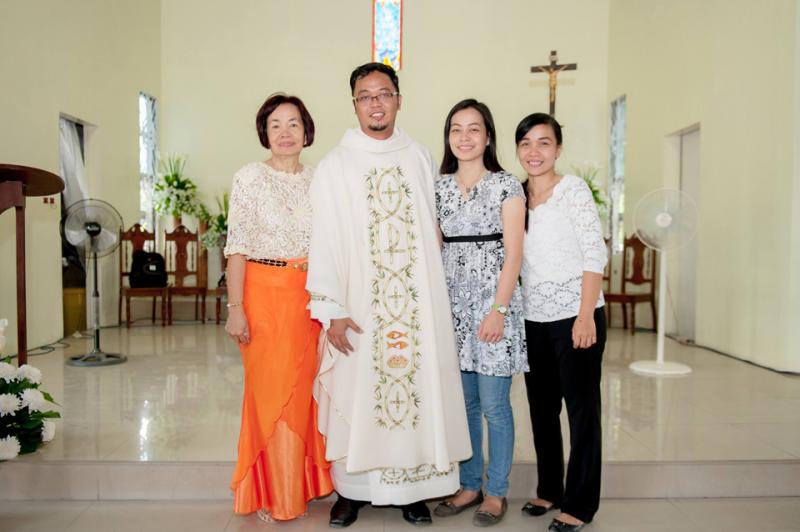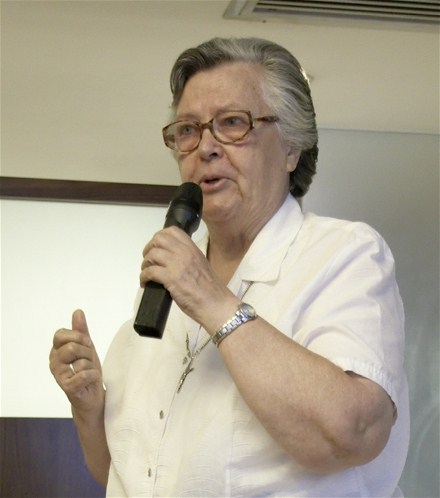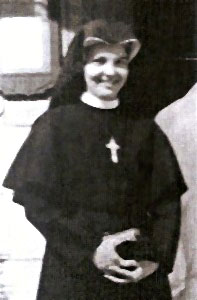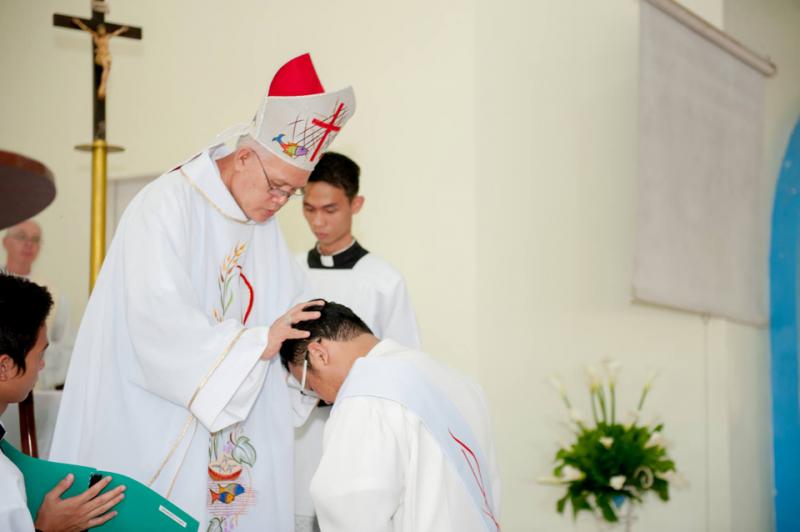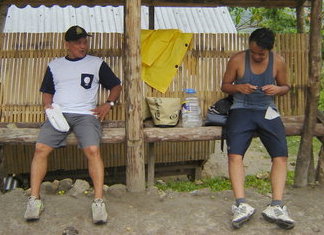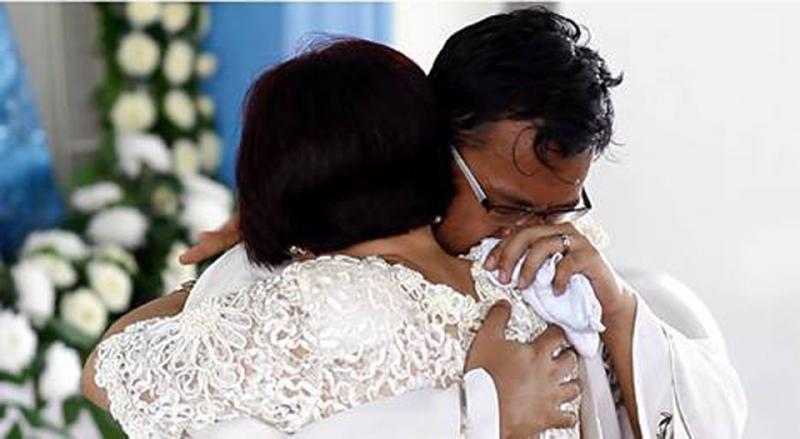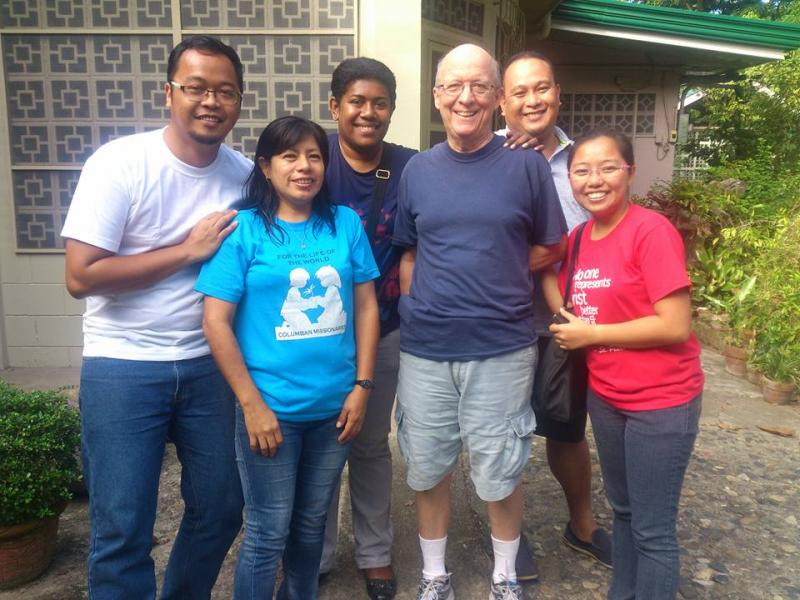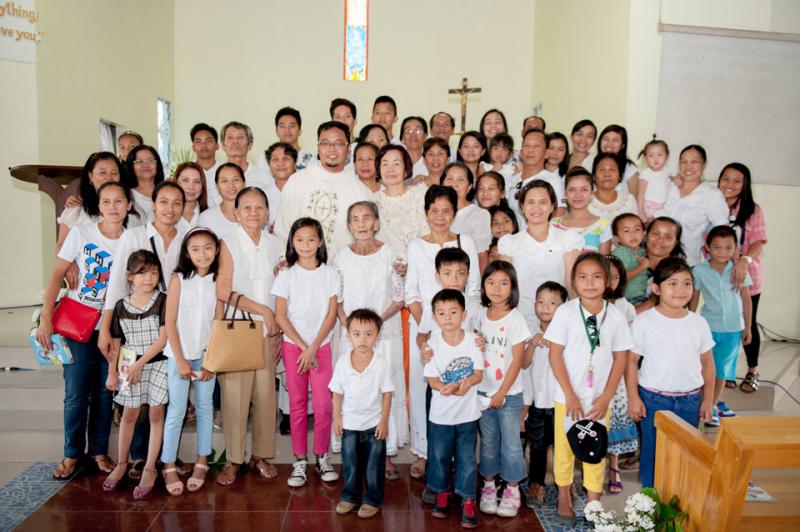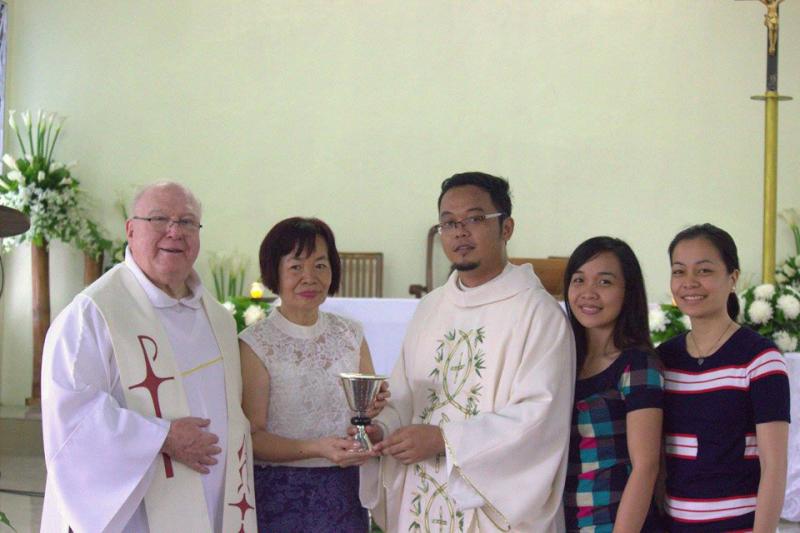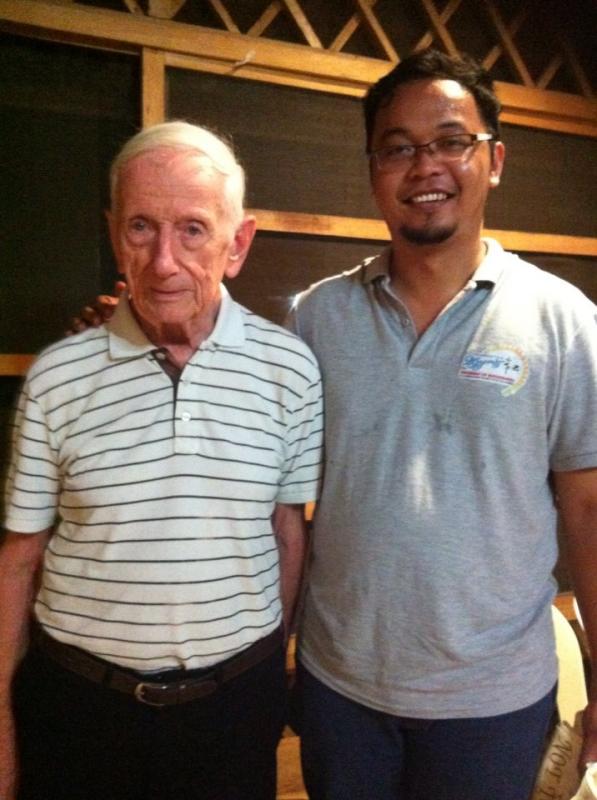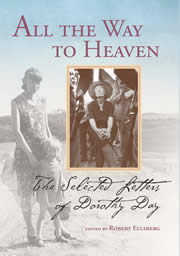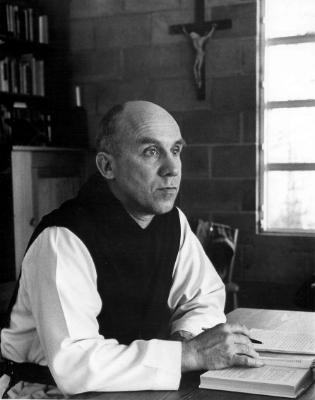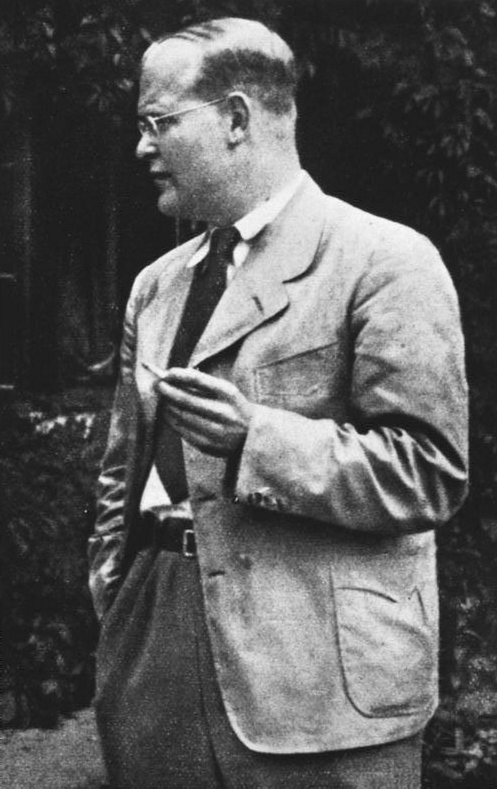Misyon Online - January-February 2016

PULONG NG EDITOR

‘The life and death of each of us has its influence on others’
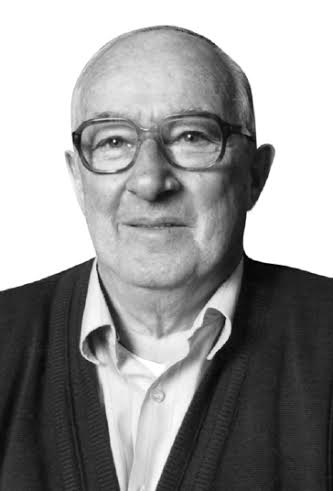
Fr Geoffrey Revatto
As I was preparing to put the obituary of Columban Fr Geoffrey Revatto online I was struck by the words of Fr Donal Hogan during his funeral homily: 'The life and death of each of us has its influence on others' (Romans 14:7). Father Geoff touched the lives of so many people – especially the poor in Negros, I think in particular of the parish of Sipalay which had been without a resident priest for 50 years till he arrived in the early 1950's.
Here was a young priest who grew up on the south coast of Ireland throwing in his lot with people on the south-east coast of Negros, without even the chance of formally studying the Hiligaynon language they spoke. But his life spoke the language of the Gospel.

WHERE HIS HEART LED HIM
Ordination to the Priesthood of Fr Kurt Pala
By Mary Joy Rile
Bishop Elenito Galido of the Diocese of Iligan noted that Fr Kurt Pala was the first Columban from the diocese to be ordained. The Columbans first arrived in what is now the Diocese of Iligan in 1938 and over the years opened up most of the parishes in the diocese. The last Columban left only a few years ago.
|
|
I’ve known Father Kurt since I began working with Misyon in 2008. I have often asked him for photos and articles. We have been sharing each other’s journey and became prayer partners. Attending his ordination was a grace. Knowing the struggles that he went through all these years, it was very special for me to witness his final YES to God! He recognized the feeling of fear as the day approached. ‘It is scarier than the deaconate ordination,’ he shared. ‘I’m so overwhelmed by the overflowing support, the excitement of everyone in the congregation, friends and relatives, Columban families who flew all the way from different and faraway places. It’s too much for me to contain. They expect so much from me. Can I even keep up with all of this?” But love was greater. With the full support of his family, his love for God brought him all the way to the altar.

‘PADRE’ DE PAMILYA
By Bernie Durangparang
The author, originally from Oslob, Cebu, is a teacher by profession but has been a member of the Columban Vocation Team for 19 years. He lives in Ozamiz City.
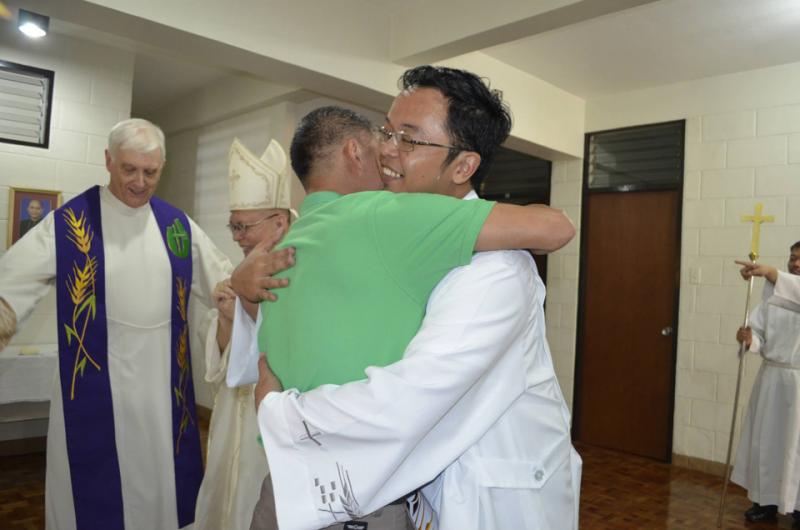
I recently cried at an ordination. Kurt Pala finally made his commitment at the altar as a priest on 21 November 2015. I was more than happy to have accompanied him in his discernment process since he was in 4th year high school. Truly it is a joy to be part of the vocation team for 19 years now. The greatest moment for me at Father Kurt’s ordination was when I approached him after the ceremony to kiss his anointed hands. He instead spontaneously embraced me and whispered, ‘Salamat kaayo, Kuya (Thank you so much, Elder Brother)’ . I could only shed a tear at that humbling moment as I uttered, ‘Congratulations, Kurt. Na-pari na gyod ka. (You are now truly a priest)’ .

NOW A SPOKEN THANKS

The Columban Sisters have been present in China since 1926
This appeared as an editorial by ‘JiM’ in the 22 November 2015 issue of Sunday Examiner, the English-language Catholic weekly of the Diocese of Hong Kong. The Columban Sisters were invited to go to Hong Kong in 1947 and left in December 2015.
Sixty-seven years make up a substantial portion of any one lifetime, even a significant period in the brief history of Hong Kong, but less than a blink of the eye in the time frame of the divine. However, it is not by the number of years that we measure the contribution to life and society of those who walk this earth, but the quality of commitment, breadth of imagination, ingenuity in work and, most especially, depth of love.

MISSION COMES FULL CIRCLE
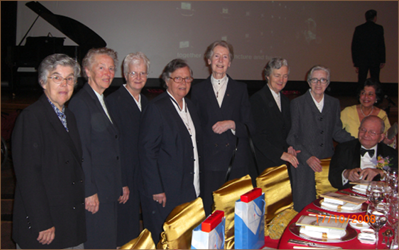
Columban Sisters with longtime supporter, Rusy Schroff and his wife,
from left, Sr Nora Mary O’Driscoll, Sr Valerie Hetherton, Sr Nuala Raleigh,
Sr Fintan Ryan, Sr Victoire Ryan, Sr Rita Deegan and Sr Mary Greaney.
Photo: The Hong Kong Tuberculosis Chest and Heart Diseases Association
This was one of a number of articles in the 22 November 2015 issue of Sunday Examiner, the English-language weekly of the Diocese of Hong Kong on the occasion of the Missionary Sisters of St Columban leaving Hong Kong in December 2015 after a presence of 68 years. You will find all the articles on the website of Sunday Examine here.
Seven Columban Sisters, all of whom had worked at the Ruttonjee Sanatorium, as the current general hospital in Wan Chai used to be known, traveled from Ireland to join the 60th anniversary celebration of the Hong Kong Tuberculosis Chest and Heart Diseases Association (formerly the Anti-Tuberculosis Association) during October 2008.

A TALE OF TWO COMMUNITIES
By Fr Cireneo Matulac
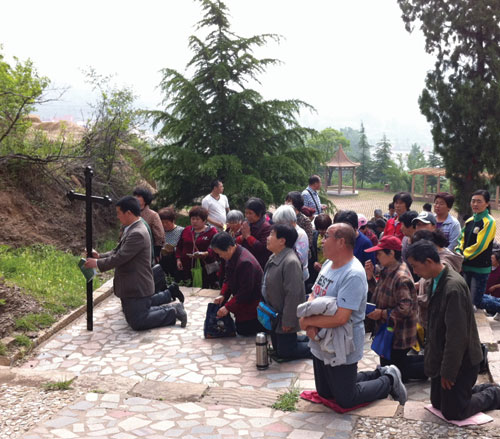
One of the communities in China visited by Fr Matulac
The author is from Payao, Zamboanga Sibugay, in southwest Mindanao. While a seminarian he spent two years on First Mission Assignment in Chile. After his ordination he went on mission to China. He is now Vice-Rector at the Columban House of Studies in Cubao, Quezon City. He has contributed a number of articles to MISYONonline.com over the years.
Recently I visited some small Catholic communities in the north of China. I visited one particular community, with little more than ten families gathered together, with the Parish Priest. He asked me to give a short talk to the congregation while he was hearing confessions. I thought I would say something on reconciliation and forgiveness. I introduced myself as a missionary priest from the Philippines, a member of the Missionary Society of St Columban.
Columbans work in many places in Asia: China, Korea, Pakistan, Taiwan and the Philippines. I spoke to them of the ministry of reconciliation between Muslims and Christians in Mindanao.

ATTORNEY FRANCISCO B. CRUZ
‘A light in the darkness during those Martial Law years’
By Fr Seán Coyle
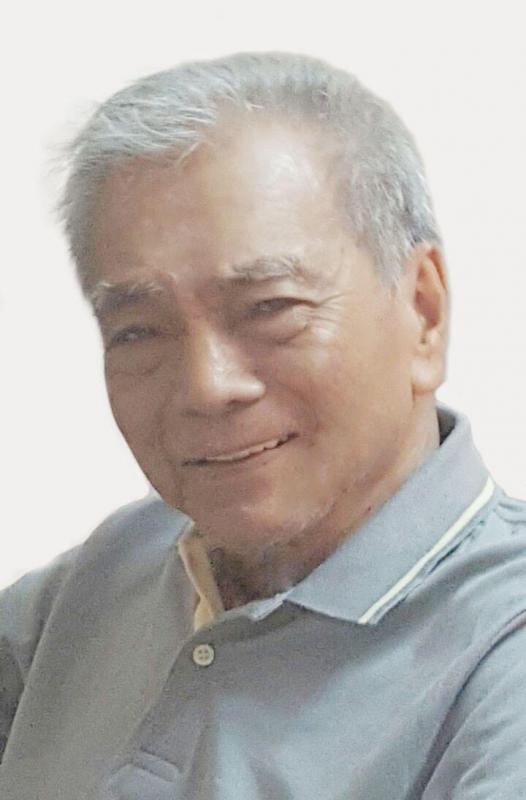
Attorney Francisco B. Cruz, Knight of St Sylvester
(8 July 1931 – 18 October 2015)
This article is an edited version of a letter published in The Visayan Daily Star on 23 October 2015.
On 18 October 2015 a great human being and outstanding Christian died in Bacolod City, Attorney Francisco B. Cruz, on the eve of the sixth anniversary of his receiving the City’s Banwahanon Award.
This was given ‘for his selfless and free legal service extended to the poor and his vigilance and devotion to the practice of law for over 40 years. He was also cited for his untiring efforts to give an example of law as the vehicle for justice and peace.’
Attorney Cruz was made a Knight of the Pontifical Equestrian Order of St Sylvester, Pope and Martyr, by the Vatican. Membership of the Order ‘is intended to award Roman Catholic laymen who are actively involved in the life of the church, particularly as it is exemplified in the exercise of their professional duties and mastership of the different arts.’

I’m A Missionary And I’m A Lay Person
By Jhoanna Resari
This article first appeared in the 25 October 2015 issue of Sunday Examiner, the English-language weekly of the Diocese of Hong Kong and is based on an interview with Columban Lay Missionary Jhoanna Resari who is now based in Hong Kong as a member of the Lay Missionary Central Leaderships Team. She worked in Taiwan from 2005 until 2014 and has featured on MISYONonline.com a number of times.
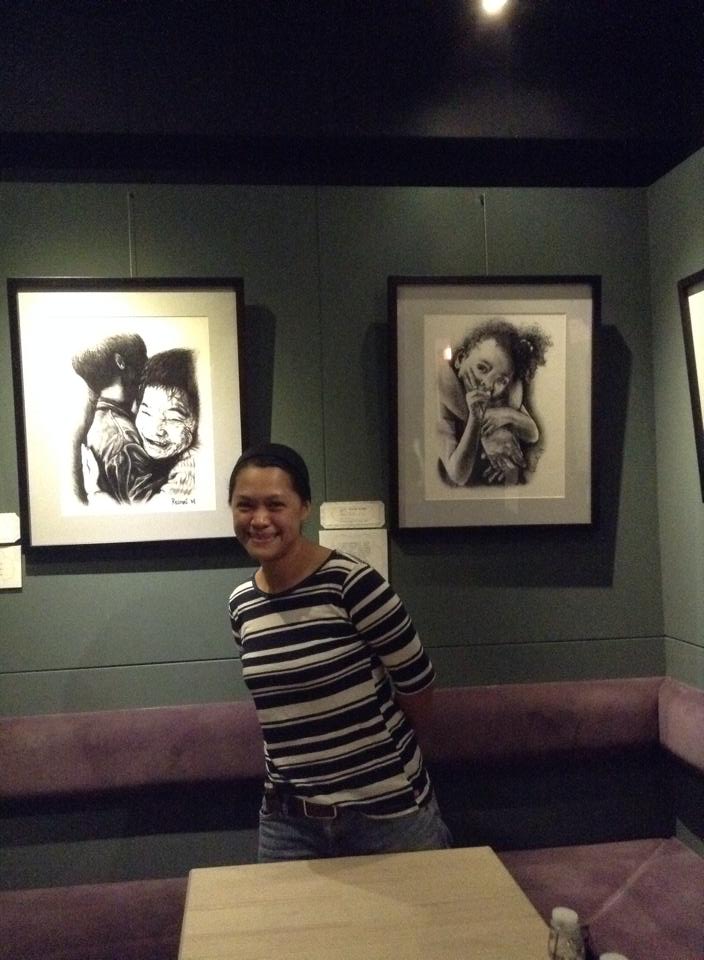
Jhoanna Resari at an exhibition of her art work
HONG KONG (Mabuhay): Jhoanna ‘Jao’ Resari is a fully-fledged missionary, but she is not a sister. She is a lay person and that is what she wants to be, but she also wants to be a missionary.
‘But I did not always know that,’ she admits. ‘While I was studying in Manila I knew I was looking for something I could not quite define, but I did pray to God to help me find a way.’
She received her reply when, for a reason she cannot remember, she went to a different church one Sunday where a large banner was proclaiming something about lay mission. ‘I thought that’s the answer to my prayer and wanted to sign up straight away.’
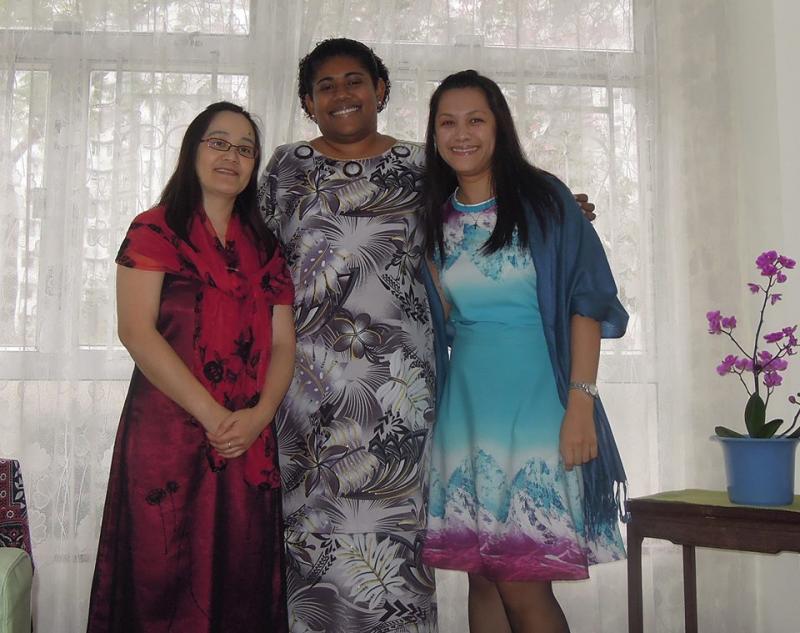
Gracia Kibad, Lanieta Tamatawale and Jhoanna Resari, Hong Kong
Gracia is the Coordinator of the Lay Missionary Central Leadership Team. From Bauko, Mountain Province, Philippines, she worked in Ireland from 1996 until taking up her present position in 2014. Lani, from Fiji, has worked in the Philippines and in Fiji.
But God’s ways are not always simple and she needed three year’s work experience to be accepted. ‘So I took a job as a graphic artist and joined a volunteer group, spending my free time working in community projects and disaster response teams,’ she related. But the feeling did not die and when the three years were up, she retrieved the pamphlet and contacted the Columban Lay Missionaries (CLMs).
That was in 2005 and Jao describes her experience since then as a voyage into a world she could not even have dreamed of.
‘We had nine months preparation. We had modules on Scripture, sociology, missiology, history and all sorts of wonderfully interesting things. I did three months of Clinical Pastoral Experience (CPE), accompanying patients in hospital and had an experience in the Muslim-majority Marawi City, as well as in Cagayan de Oro.’
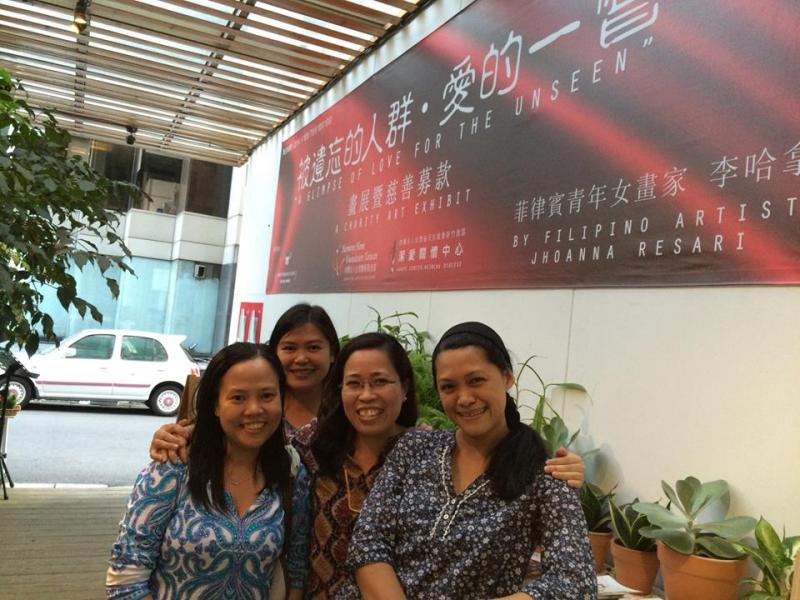
CLMs from the Philippines in Taiwan L to R: Joan Yap (Ipil, Zamobanga Sibugay), Sherryl Lou Capili (Silang, Cavite), Reina Mosqueda (Los Baños, Laguna), Jao Resari
Then she went to Taiwan, where she lived with other lay missionaries and began learning Mandarin, and how to care for children and adults who are living with HIV/AIDS. ‘But I also learned about the stigma,’ she said. ‘So I started an education campaign in parishes and other communities for awareness and prevention.’
Jao said this was where her preparation began to make real sense. ‘I remembered that we had studied The Dogmatic Constitution on the Church (Lumen Gentium) of Vatican II.’ It emphasizes the universal call to holiness, which applies to all the people of God—clergy, religious and lay people. It states, ‘all the faithful of Christ of whatever rank or status, are called to the fullness of the Christian life and to the perfection of charity; by this holiness as such a more human manner of living is promoted in this earthly society’ (No 40). Lumen Gentium further says of the laity that ‘they carry out for their own part the mission of the whole Christian people in the Church and in the world,’ (No 31).
In March 2014, Pope Francis, in a message to a conference on’ The Lay Christian’s Mission in the City’, referred to Vatican II saying that ‘the lay faithful, in virtue of their Baptism, are protagonists in the work of evangelization and human advancement’.
While there have always been lay missionaries in the Church, in the second half of the last century the vocation became better recognized, and stronger structures and support mechanisms were put in place. Often programs are built on skill-sharing and people go to foreign lands to share, not only their faith, but also their professional knowledge.
Today, most countries where the Church is well established have national lay mission societies, as do major mission congregations. ‘But I joined the Columbans,’ Jao said. ‘This year we celebrate 25 years. We are a mixed group of women and men from several countries; single persons and married couples with children, who feel called to respond to God’s mission.’
She describes the way lay missionaries give witness through living simply and being with the poor, the marginalized and the exploited earth, as a great joy. ‘It was my first time in a country where Catholics are a minority and local people asked me lots of questions about what a lay missionary is,’ she said.
‘All I could say is I am happy with my vocation as a lay person, but I do want to respond to God’s call to mission and be involved in building a Church that is part of the lives of the poor and marginalized. I learned over time that living close to people whom society has rejected, says more of what it means to live the faith I grew up in.’
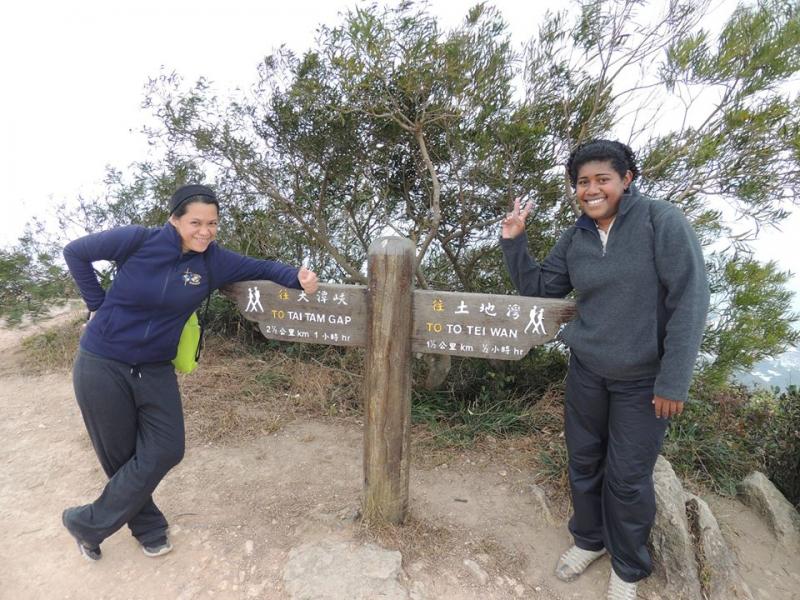
Jao and Lani in the hills of Hong Kong
At present, there are 49 lay missionaries from South Korea, Fiji, Tonga, Chile, Philippines, Ireland and Peru. They serve in eight regions around the Asia Pacific area, in Britain, in Ireland, and at the El Paso / Ciudad Juarez border between the USA and Mexico.
‘We live out our spirituality in the Church and in the secular world. We immerse ourselves in justice, peace and integrity of creation issues, interreligious dialogue, as well as work with youth, indigenous peoples, parish communities, migrants, victims of human trafficking, asylum seekers and refugees,’ Jao explained.
Ten years ago, Jhoanna signed on for three years, but as her life attests, there is always room for three more years . . . and three more years...
In 2014 year she signed on for another six.
Lani Tamatawale speaks about her experience in the Philippines
Interested in knowing more about the Columban Lay Missionaries?
Email Gracia Kibad in Hong Kong: clmcltcoordinator@gmail.com or Arlenne Villahermosa in Quezon City, Philippines: clmssc_phil@yahoo.comYou will find Columban Lay Missionaries – Philippines (CLM-P) on Facebook here. The CLM-P blog is here.
Pulong ng Editor

‘The life and death of each of us has its influence on others’

Fr Geoffrey Revatto
As I was preparing to put the obituary of Columban Fr Geoffrey Revatto online I was struck by the words of Fr Donal Hogan during his funeral homily: 'The life and death of each of us has its influence on others' (Romans 14:7). Father Geoff touched the lives of so many people – especially the poor in Negros, I think in particular of the parish of Sipalay which had been without a resident priest for 50 years till he arrived in the early 1950's.
Here was a young priest who grew up on the south coast of Ireland throwing in his lot with people on the south-east coast of Negros, without even the chance of formally studying the Hiligaynon language they spoke. But his life spoke the language of the Gospel.
Father Geoff’s courage in the last two decades or so of his life when he came to terms with an illness that left him in a wheelchair, which he drove skillfully around the corridors of St Columban’s, Dalgan Park, where he had entered as a seminarian in 1943, inspired us Columbans who knew him.

Fr Donal Hogan with Mr Ariel Abella, Ambassador of the Philippines to Ireland (2011)
Fr Hogan gave us an insight into Father Geoff’s courage and patience when he recalled a moment at lunch one day: ‘In more recent times when Geoff was confined to the wheelchair, I remember at lunch complaining about the terrible day’s golf. Geoff smiled and said to me, “Any day you can play golf is a ‘Good Day!’” It was so true and made me realize how much I take for granted in life.’

Attorney Francisco B Cruz
In the article in this issue on the late Attorney Francisco B Cruz, Fr Hogan says, ‘For me personally he was a rock of support, always available to listen and then to take up cases that seemed hopeless. He was truly a light in the darkness during those martial law years. He brought a ray of hope to people in seemingly hopeless situations. He was a true friend who sacrificed his life for others.’
These are just two men, among many men and women, of whom St Paul’s words, ‘The life and death of each of us has its influence on others’ are absolutely true, particularly in their lives.

Fr Cireneo Matulac
Fr Cireneo Matulac, ordained 53 years after Fr Geoff Revatto, is a Columban from Mindanao who has worked in Chile and in China. His article in this issue, A Tale of Two Communities, tells us how the death of Fr Rufus Halley, an Irish Columban, in Mindanao in 2001, influenced a Catholic community in China who had never heard of him until Fr Matulac visited and told them his story. Unlike Fr Revatto and Attorney Cruz, he didn’t die peacefully in bed but was ambushed and killed on the side of the road.

Fr Rufus Halley
One of the brothers of Father Rufus said at his funeral, ‘Rufus’s death will influence a great number of people to continue the great work that he has been involved with.’ Among those were the Catholics whom Fr Matulac – ordained the year after the killing of Fr Halley – visited in a relatively remote part of China.
Truly, ‘The life and death of each of us has its influence on others.’
A Tale of Two Communities
By Fr Cireneo Matulac

One of the communities in China visited by Fr Matulac
The author is from Payao, Zamboanga Sibugay, in southwest Mindanao. While a seminarian he spent two years on First Mission Assignment in Chile. After his ordination he went on mission to China. He is now Vice-Rector at the Columban House of Studies in Cubao, Quezon City. He has contributed a number of articles to MISYONonline.com over the years.
Recently I visited some small Catholic communities in the north of China. I visited one particular community, with little more than ten families gathered together, with the Parish Priest. He asked me to give a short talk to the congregation while he was hearing confessions. I thought I would say something on reconciliation and forgiveness. I introduced myself as a missionary priest from the Philippines, a member of the Missionary Society of St Columban.
Columbans work in many places in Asia: China, Korea, Pakistan, Taiwan and the Philippines. I spoke to them of the ministry of reconciliation between Muslims and Christians in Mindanao.
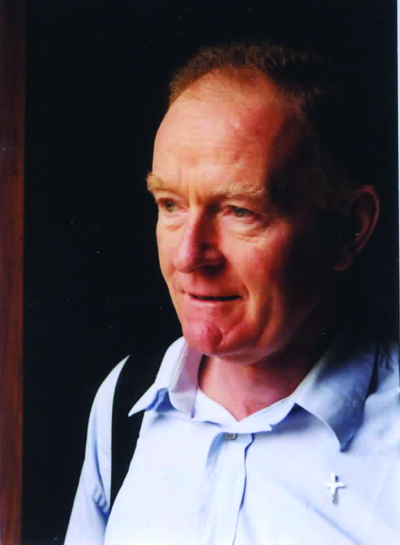
Fr Rufus Halley
I told the story of Fr Rufus Halley, an Irish Columban who had spent many years working among the Muslims. He was known for his work as a peace-builder and was loved by the people. However, on 28 August 2001, while riding his motorbike from an interfaith meeting in Balabagan, Lanao del Sur, back to his nearby parish, Malabang, a group of armed men stopped him and tried to kidnap him. He refused to go with them. They tried dragging him, but he resisted and eventually they shot him and he died on the spot. His body was left on the road. Both communities of the parish, Christian and Muslim, were deeply saddened by this event. All of them had lost a good friend.
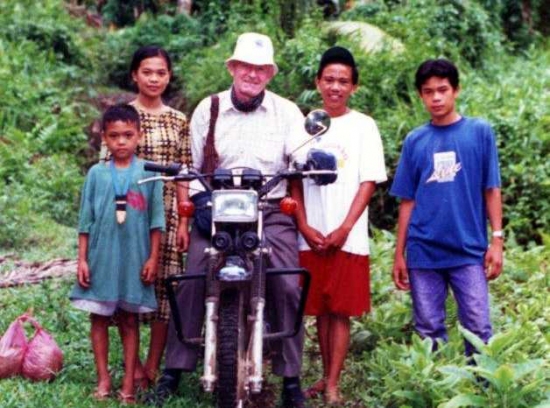
Fr Rufus Halley with young friends
A month later, three people were arrested as suspects for his murder. It turned out that they were Muslims. Friends of Father Rufus who used to visit the local prison sat down together to decide whether they would visit those arrested for killing him.
As I told this story to the members of the Chinese community, I asked them, ‘Should these friends of Father Rufus have visited those accused of killing him?’ One woman stood and said that as a Christian one should visit, but it would be so difficult that she was not sure if she could do it herself. The hurt would be just too deep. Another said much the same thing. A man said that he would encourage the friends to visit those accused, because Jesus had said ‘Love your enemies’.
As the discussion went on it became clear that the gathered community agreed on what should be done, but questioned whether they themselves would have the strength or the courage to forgive. As I listened I told them that Father Rufus’s friends had had a similar discussion and had come to the conclusion that he would want them to visit. So they did go and visit the accused. This was certainly a great act of forgiveness. Our ability to forgive those who have done us wrong is the first step towards reconciliation. When we are ready to forgive our enemy, we give reconciliation a chance.
Columban Frs Cireneo Matulac, Kevin McHugh and Leo Distor
Fr McHugh worked for many years in Balabagan.
After our discussion, a man at the rear of the room raised his hand and said that he too had a story to tell. In his home village, during China’s Cultural Revolution (1966 – 1976), there was a man who denounced the Christians of the village and was responsible for much destruction. This man burned the Catholic church in the village and denounced the chief catechist so that the latter was imprisoned for a very long time. In the 1980s the chief catechist was eventually released from prison. The man who had denounced him was by now old and seriously ill. Since he was known for his tyranny, the neighbors simply ignored him. His sickness brought this man much physical pain. The man he had denounced and had served such a long prison sentence went to visit him. Despite his previous suffering he was willing to forgive. He even persuaded his friends to visit him also.
Because of this kindness, the sick man asked why he was doing this. The catechist replied that this was the essence of Christianity: we were to forgive even as God forgives. Eventually, the sick man on receiving such care, concern and forgiveness from his neighbors decided to become a Catholic himself. I found this a very profound story of reconciliation: an instance where a community who had endured communal conflict had received the grace to be reconciled when the violence was over.
All Christians are called to respond to Christ’s command, ‘Go into all the world and proclaim the good news to the whole creation’ (Mark 16:15). How do we proclaim the Good News? I think that these two stories show us that we proclaim the gospel above all by the way we live our Christian lives. God’s work in us must be evident in the quality of our daily lives.
This article first appeared in the September-October 2015 issue of Far East, the magazine of the Columbans in Ireland and Britain.
‘Rufus’s death will influence a great number of people’‘Rufus’s death will influence a great number of people to continue the great work that he has been involved with.’ These words of one of the brothers of Fr Rufus Halley in the AP report above were fulfilled in the Catholic community that Fr Cireneo Matulac visited in China. ‘Mercy is the heart of God. It must also be the heart of the members of the one great family of his children: a heart which beats all the more strongly wherever human dignity – as a reflection of the face of God in his creatures – is in play. Jesus tells us that love for others – foreigners, the sick, prisoners, the homeless, even our enemies – is the yardstick by which God will judge our actions. Our eternal destiny depends on this.’ (Pope Francis, Message for World Day of Peace, 1 January 2016).
You may read the tribute to Fr Rufus Halley by his close friend Gaudencio B. Cardinal Rosales, Archbishop Emeritus of Manila, here. |
Attorney Francisco B. Cruz
‘A light in the darkness during those Martial Law years’
By Fr Seán Coyle

Attorney Francisco B. Cruz, Knight of St Sylvester
(8 July 1931 – 18 October 2015)
This article is an edited version of a letter published in The Visayan Daily Star on 23 October 2015.
On 18 October 2015 a great human being and outstanding Christian died in Bacolod City, Attorney Francisco B. Cruz, on the eve of the sixth anniversary of his receiving the City’s Banwahanon Award.
This was given ‘for his selfless and free legal service extended to the poor and his vigilance and devotion to the practice of law for over 40 years. He was also cited for his untiring efforts to give an example of law as the vehicle for justice and peace.’
Attorney Cruz was made a Knight of the Pontifical Equestrian Order of St Sylvester, Pope and Martyr, by the Vatican. Membership of the Order ‘is intended to award Roman Catholic laymen who are actively involved in the life of the church, particularly as it is exemplified in the exercise of their professional duties and mastership of the different arts.’
On the occasion of Attorney Cruz’s receiving the Banwahanon Award columnist Rolly Espina of The Visayan Daily Star wrote : ‘Lawyer Francisco Cruz is one who remained committed to the rule of law and stood pat on his fight for human rights. During the Martial Law years, Cruz often was battered and pilloried by minions of the late President Ferdinand E. Marcos. But he remained indomitable in his courageous advocacy of what is right despite the resources of the administration.’
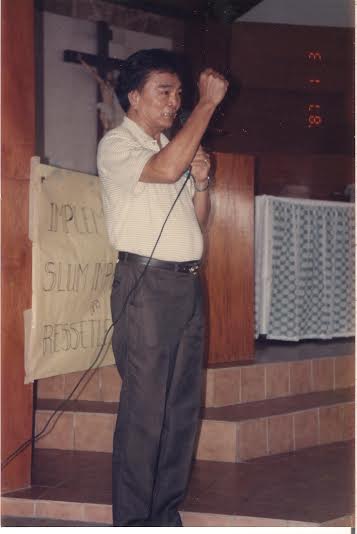
Attorney Cruz addressing people in a parish church
My Columban confrere Fr. Donal Hogan, who worked for many years in southern Negros Occidental, echoed the words of Rolly Espina in an email from Ireland: ‘Thinking of Frank, Luke 4:16 - 21 comes to mind. By his professional advocacy he proclaimed good news to the poor, obtaining the release of captives and liberty for those who were oppressed. In the 1970s and 1980s when I was in Magballo and Candoni (Negros Occidental) this scripture was fulfilled through Frank's courageous efforts on behalf of the poor who were hungering for justice.
‘For me personally he was a rock of support, always available to listen and then to take up cases that seemed hopeless. He was truly a light in the darkness during those martial law years. He brought a ray of hope to people in seemingly hopeless situations. He was a true friend who sacrificed his life for others.’
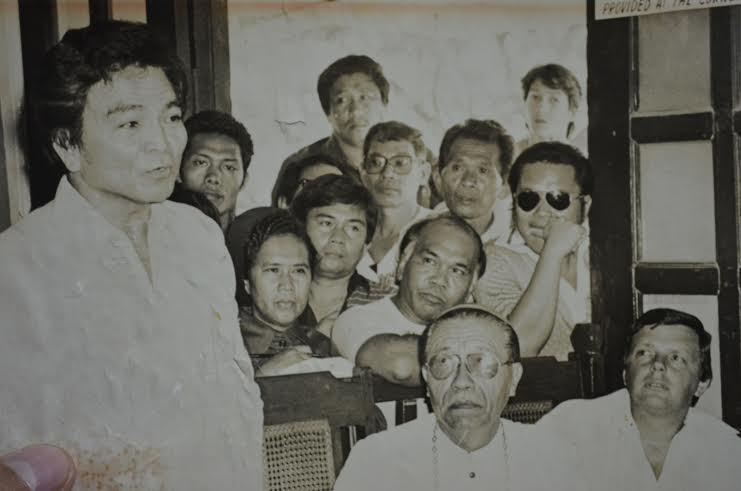
Attorney Cruz in a courtroom with Bishop Antonio Y. Fortich, Bishop of Bacolod 1967 - 1989
We Columbans will be forever grateful to the late Attorney Cruz for his defense in the mid-1980s of the Negros Nine, among whom were two Columban priests, Fr Brian Gore and the late Fr. Niall O’Brien, falsely accused of murder.
I was particularly touched that Attorney Cruz died on the day on which these words of Jesus were proclaimed at all Masses throughout the world in the Gospel: ‘Whoever wishes to be great among you will be your servant; whoever wishes to be first among you will be the slave of all. For the Son of Man did not come to be served but to serve and to give his life as a ransom for many’ (Mark 10:43-45).
In Ireland we have a beautiful prayer when someone dies: ‘Ar dheis Dé go raibh a anam uasal’ – ‘May his noble soul be at the right hand of God.’
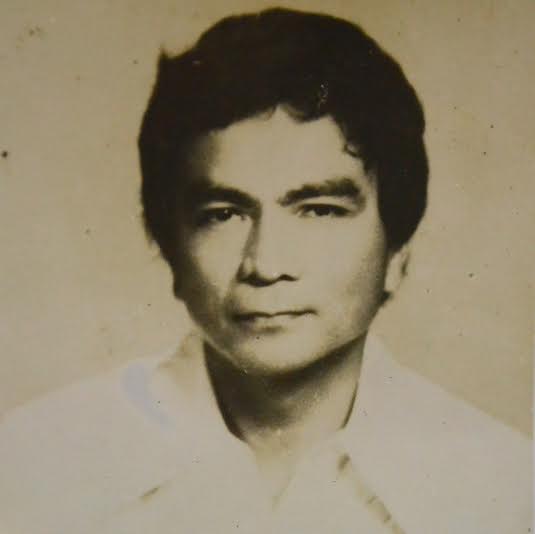
A young Attorney Cruz
Homily at Funeral Mass of
Attorney Francisco Cruz
By Bishop Vicente M. Navarra, Bishop of Bacolod
Bishop Vicente M. Navarra
Bishop Navarra gave this homily at the funeral Mass of Attorney Cruz in San Sebastian Cathedral, Bacolod City, on 24 October 2015.
The bereaved family of the late SK (Sir Knight) Francisco Frankie Cruz, dear brothers and sisters in Christ:
The Book of Revelation 14:13 says, ‘Write this down: Happy now are the dead who die in the Lord... Yes they shall find rest from their labors, for their good works accompany them.’
But, last October 19, most of us felt a contrary feeling, human as we are, because of the tragic news we heard, that a great man and a very good friend had succumbed to death after months of illness that most of us did not even know about.
Yes, SK and Attorney Francisco ‘Frankie’ Cruz had died. In the relatively limited span of years that I knew Frankie - for me he was a man of faith, of dedication to his profession and work, a man of honor, a loving husband to his wife and a model father to his children. To his friends and acquaintances, like me, he was a man of honor.
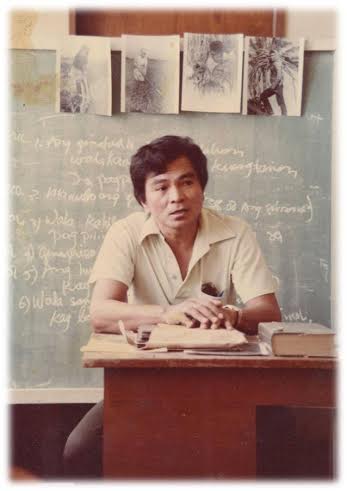
Attorney Cruz at a barrio seminar
It was in 1988, when I was appointed as first bishop of the newly-created Diocese of Kabankalan, that I came to know Attorney Frankie Cruz, because he used to visit our Social Action Office in order to attend to poor and harassed church workers of the southernmost part of Negros Occidental who were his clients when that area was still part of the Diocese of Bacolod. And his services pro bono continued on behalf of the Diocese of Kabankalan until the early 1990s.
That time, I already learned to appreciate the goodness and nobility of Attorney Frankie Cruz when it comes to service in helping the cause of the poor and upholding the rights of the Church. His work and his dedication to his profession as a lawyer impressed me. I saw that he was a person who could be trusted, because he relied not only on his professional proficiency and expertise. Even more, I saw him as a man of conscience who felt what a good Christian should feel towards his fellow Christians or fellowmen who were oppressed and unjustly treated.
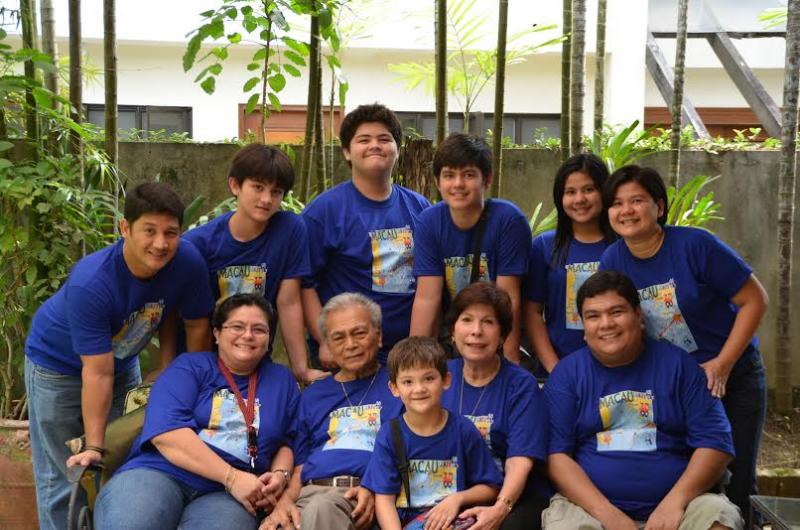
The Cruz Family
Standing (l to r): Manuel Fortun, Joaquin Fortun, Franco Fortun,
Kerl Cruz, Kiara Cruz, Girl Cruz (all grandchildren)
Sitting (l to r): Jenna Fortun (daughter), Frankie Cruz, Julio Fortun, Lita Cruz, Kerr Cruz (son)
When I was transferred to Bacolod as bishop (in 2001), I became close to Frankie and his family because he was present at most of the solemn and official liturgical celebrations of the diocese, being a knight of St Sylvester. He was also our consultant in legal matters of the diocese involving the rights of the Church and of the materially poor sectors of society.
I knew him as a faithful and model husband and family man, because on several occasions, we would go together, enjoying our lunch of paella and callos at the then eatery El Rincon at the Robinsons Place Mall, managed and partly-owned by Lita his beloved wife. And as we relished our food, we enjoyed together his sharing of current events and his jokes.
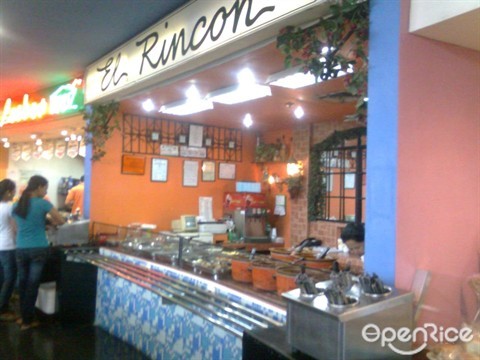
El Rincon, Robinsons Place, Bacolod City
El Rincon is no longer in operation
But, I really came to have a great appreciation and respect for his courage and nobility of spirit, when he experienced the ‘Waterloo’ in his career as a lawyer, because as I understood his case, he incurred the ire of the Supreme Court, as he defended the case of his client. The human but fallible intricacies of civil law led to his disbarment (in 2005) - a stigma which he himself said he would carry with him to his grave, because he wouldn’t budge - in to what is demanded of him by the Supreme Court, believing in conscience that he was right and was on the side of Truth and Justice. [Editor’s note: Attorney Cruz was suspended but not disbarred. At the time of the suspension in 2005 Bulatlat.com reported: ‘Bishop Vicente Navarra, the clerics and staff of the Diocese of Bacolod expressed shock, saying how can it be done to “a good man, who has faithfully served indigent clients not just for free but even spent his own resources for travel, food and other expenses.”’]
And I believe that the persons responsible for the persecution of Attorney Frank Cruz must have been stricken to the core by his resolute defense of his rights and the rights of his client, which alone was vindication enough coming from God on behalf of people who are ready to remain faithful in defense of the Truth despite martyrdom of mind and spirit like what Attorney Cruz did and eventually suffered its adverse consequences.
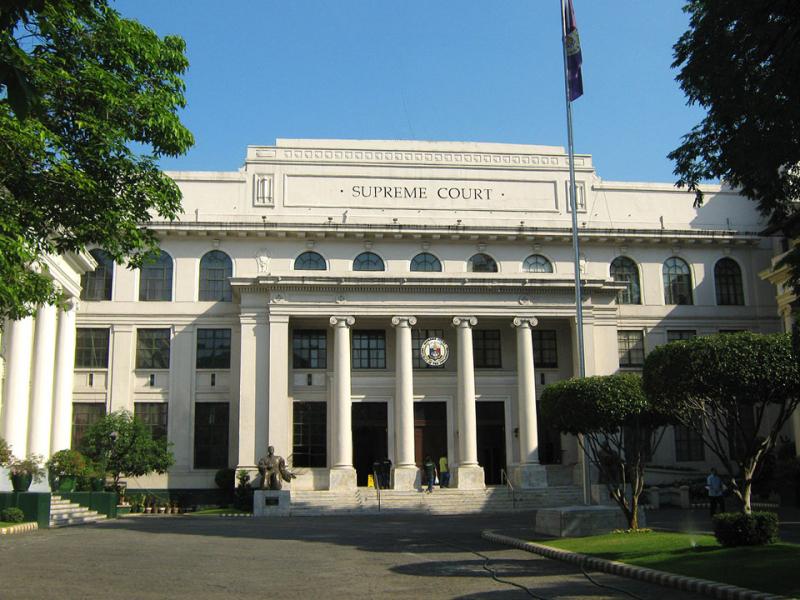
Supreme Court Building, Manila [Wikipedia]
I was talking to Lita, his beloved wife and widow, on October 19 when I blessed the remains of Frankie at Acropolis Garden Funeral Homes. She shared how Frankie practiced his faith: A Catholic man who would regularly go to confession, a man of prayer and contemplation who could memorize devotional prayers which she herself could not. And she showed me the regalia Frank would wear as a Knight of St Sylvester during solemn liturgical services, when his attendance was needed.
What consoled me most about the pious death of Attorney Frank Cruz, was what Lita confided to me, that the priest who heard the last confession of Frankie, and who anointed him a few days before he expired, told her that Frankie made a very good confession. He was at peace and all ready to meet his Lord and King whom he had served and guarded as a loyal Knight of St Sylvester.
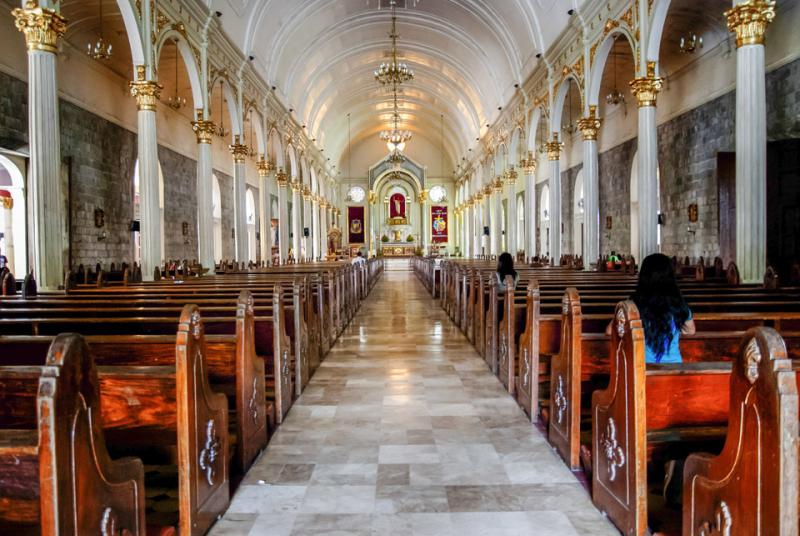
San Sebastian Cathedral, Bacolod City [Wikipedia]
My dear friends, as you were listening to my homily, you might have thought that I was giving a eulogy to our beloved departed. Take it as you want it, but I have to mention everything I know of Frank, because I want to arouse in you and in all of us the truth of the scriptural passage I mentioned at the start of my homily, when I quoted the Book of Revelation 14: 13 – ‘Happy now are the dead who die in the Lord... Yes they shall find rest from their labors, for their good works accompany them.’What is the reason or the reasons why our good and dear Frankie refused to have attached to him all the tubes that doctors prescribe to prolong or to revive the life of a dying person? Why did he make Lita decide to discontinue the use of the respirator on him? Why was he so well composed and disposed, calm and peaceful, resigned and ready, as he lay on his ICU bed waiting for his dear divine Friend to come and fetch him to the everlasting abode?
Why? Because he was ready and was all set to go. He was ready because he knew he was with the Lord… and that he would eventually rest from the labors of this world that can only oppress and depress, but because he labored not for himself or for any other despicable worldly ambitions… so he was ready, because all his labor turned out to be meritorious good works, and they turned to be his full spiritual regalia, not only as a good and faithful Knight of St Sylvester and a conscientious Catholic layman, a faithful husband, an exemplary father, and a very good friend, but most of all as an exemplary Christian soul clothed with the paraphernalia of good works and with his lamps lighted because of his exemplary Christian life which invites all of us to do the same.
May his blessed soul rest in peace. Amen!
Mission comes full circle

Columban Sisters with longtime supporter, Rusy Schroff and his wife,
from left, Sr Nora Mary O’Driscoll, Sr Valerie Hetherton, Sr Nuala Raleigh,
Sr Fintan Ryan, Sr Victoire Ryan, Sr Rita Deegan and Sr Mary Greaney.
Photo: The Hong Kong Tuberculosis Chest and Heart Diseases Association
This was one of a number of articles in the 22 November 2015 issue of Sunday Examiner, the English-language weekly of the Diocese of Hong Kong on the occasion of the Missionary Sisters of St Columban leaving Hong Kong in December 2015 after a presence of 68 years. You will find all the articles on the website of Sunday Examine here.
Seven Columban Sisters, all of whom had worked at the Ruttonjee Sanatorium, as the current general hospital in Wan Chai used to be known, traveled from Ireland to join the 60th anniversary celebration of the Hong Kong Tuberculosis Chest and Heart Diseases Association (formerly the Anti-Tuberculosis Association) during October 2008.
Sr Isobel Loughrey saying goodbye to Hong Kong
Sister Mary Greaney said that when the Columbans began at Ruttonjee in 1948 there was a clear mission to those suffering from tuberculosis (TB). ‘They were the poor and neglected of Hong Kong at the time,’ she explained. ‘However, now the association has broadened its vision into other aspects of public health care, but it has not lost its focus on TB, which unfortunately is making a comeback in the world today.’
The World Health Organisation put TB, which was thought to have been eradicated by the 1980s, back on the critical list in 1993, anticipating around 90 million new cases to be reported in the last decade of the last century. This prompted a former medical officer at the sanatorium, Michael Iseman, to lament, ‘We knew how to cure TB, but we dropped the ball by not ensuring proper treatment.’ Iseman spoke of the breakthrough in the research done by the two Columban doctors, Sr Gabriel O’Mahony and Sr Aquinas Monahan, as well as the pioneering development of holistic care given by the sisters on the staff. ‘But sadly,’ he said, ‘We squandered a great legacy.’
At the beginning of World War II, Sister Gabriel, together with Sister Aquinas, had set off for their first day as medical students at University College Dublin, beginning what was destined to be an enduring partnership in the battle against TB, discrimination and indifference. The Congregation decided the two should wear what they termed ‘civvies’ to lectures and they often laughed as they described the different type of habit their superiors designed for them. However, being out of step with fashion did not affect their grades, as one, laid-back, male student was prompted to quip, ‘It seems the longer the skirts the higher the grades!’
After graduation, Sister Gabriel did further studies in the USA before being appointed to Hong Kong in 1950, where she joined Sister Aquinas and the Columban Sisters at the Ruttonjee Sanatorium.
Sr Mary Anthony Ryan SSC thanks the people of Hong Kong
They were a disparate group made up of Sisters expelled from mainland China, old hands from the Philippines and Burma, as well as raw recruits from Ireland and the USA, who took up the battle against the epidemic that throughout history has claimed the lives of one billion people, 150,000 of whom died in Hong Kong between 1900 and 1980.
In 1952, both sisters were invited to lecture at the University of Hong Kong and in the following years all undergraduate medical students were also taught at Ruttonjee or Queen Mary Hospital. Later in 1957, Sister Gabriel won a scholarship that allowed her to study for membership of the Royal College of Surgeons of Edinburgh (Scotland) and later did work with the World Health Organization in Nepal, India and Africa.
Ruttonjee Hospital was described as a place where the really poor were admitted and given first class professional treatment free of charge. The Sisters found peace in serving the poorest of the poor in the city, the majority of whom were refugees. Basically it was about bringing and being good news to the poor, about binding up hearts that were broken, comforting, uplifting and freeing those oppressed by sickness and poverty. It was also a place where the experience and skills of the Sisters working in conjunction with the British Medical Research Council facilitated major research projects into the new drugs for TB appearing on the market in the 1960s. Ruttonjee became the first unit in the world to seriously treat tuberculosis meningitis. It was recognized as a major player in the management of the disease.
Sr Patricia Byrne SSC leaving Hong Kong
But the boundaries of the hospital did not confine the Sisters, who visited refugee camps when they were off duty, as well as a colony for people suffering from Hansen’s Disease (leprosy) at Sandy Bay.
In the very early days they opened a dispensary in the New Territories, an area mostly deprived of medical services, and the two doctors visited regularly. It also became a happy place of respite for the Sisters on their days off, as well as the military chaplains in the area and the Jesuit scholastics.
Later a home was founded in Sandy Bay for the specialized treatment of children suffering from tuberculous meningitis. It was the first concentrated study of the care and prevention of the disease among children and resulted in considerable success in eliminating the sickness.
Reunions among the Sisters and former patients and their families continued for many years after its closure, a testament to the Sisters’ determination to know all of the families by name and take an interest in their lives. Later an asthma clinic was set up and the Sisters contributed to the founding of a hospice movement.
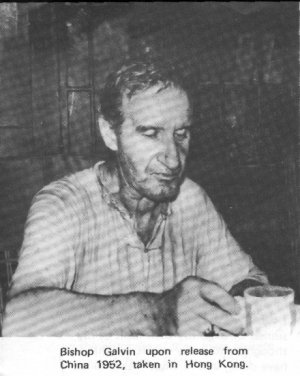
Bishop Edward Galvin, Co-Founder of the Columbans, at the convent of the Columban Sisters, Hong Kong, after his expulsion from the People’s Republic of China in 1952
But a cherished memory is the opportunity they had of welcoming priests and religious as they were expelled from China in the early 1950s, many of whom arrived traumatized and in poor physical condition.
The Sisters who traveled from Ireland for the anniversary, all mentioned that as much as they enjoyed their lives and work in Hong Kong, an age comes when it is time to slow down. Sr Mary Greaney said that during her 35 years in Hong Kong, it was always the friendship of the Chinese people that really touched her. ‘I also spent time here with the Legion of Mary,’ she added, ‘and their welcome rivaled that of the people from the TB association. Both were fantastic.’ Sister Mary said, ‘At 75, I found the pace of Hong Kong too fast. I wanted more time for myself and to enjoy being my age. I never wanted to go home, but it has worked out well.’
She explained that there have always been two great passions in her life, the Legion of Mary and the Chinese people. ‘The amazing thing about my life today,’ she went on, ‘is that in Ireland, I not only have the opportunity to work with the Legion, but also among Chinese students who are flocking into Irish universities. Our mission has come full circle and so has my life.’
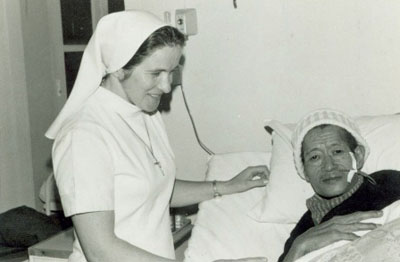
Sr Mary Greaney SSC with a patient in Ruttonjee
Now a spoken thanks

The Columban Sisters have been present in China since 1926
This appeared as an editorial by ‘JiM’ in the 22 November 2015 issue of Sunday Examiner, the English-language Catholic weekly of the Diocese of Hong Kong. The Columban Sisters were invited to go to Hong Kong in 1947 and left in December 2015.
Sixty-seven years make up a substantial portion of any one lifetime, even a significant period in the brief history of Hong Kong, but less than a blink of the eye in the time frame of the divine. However, it is not by the number of years that we measure the contribution to life and society of those who walk this earth, but the quality of commitment, breadth of imagination, ingenuity in work and, most especially, depth of love.
The Missionary Sisters of St Columban surpass in all four. Although never numerous, they brought creative, meticulous and high quality medical care to Hong Kong, injected great ingenuity into their schools, imagination into palliative care that the city had never dreamed of, walked among and welcomed sex workers and were creative in cancer counseling, as well as prison and hospital chaplaincy services.
But life was never only about science and technical expertize, it was always about love inspired by faith in the God who saves. Their ministries aimed for holistic development, physical and spiritual, and they were at the forefront of the foundation of the Catholic Nurses Guild, the Catholic Doctors Guild and the Legion of Mary. While life was hectic, there was time for everyone, staff and patients were welcomed as part of their Columban family. The Sisters’ particular interest in each individual in their medical, educational and social service endeavors is remembered fondly and cherished.
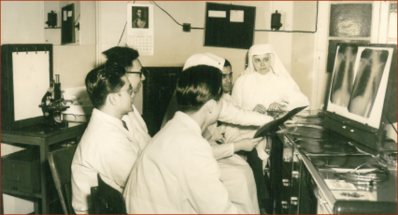
Sisters Aquinas and Gabriel confer with medical colleagues
An English nurse, who worked at Ruttonjee for 30 years, reminisced, ‘I enjoyed the work tremendously. It was so worthwhile and satisfying and I so enjoyed the nuns, all of who had a great sense of humor. The work was meticulous, the patients, most of whom were very ill, so ill in fact that I wondered how they managed to walk around and do their daily chores before being admitted. In the early days there was little money… medical equipment was scarce… loaned from ward to ward… Ruttonjee was a place of terrific cooperation… memories are of a very happy place.’
In his 2009 Gerald Choa Memorial Lecture, S. H. Lee reminisced on the era when his generation of doctors trained at Ruttonjee, saying, ‘The Hong Kong Tuberculosis Association had considerably been benefited by the dedication and devotion of the Catholic Sisters from St Columban Mission of Ireland in providing quality care and love to the patients.’ A talented surgeon, Choa had been a great supporter of the Sisters in his lifetime, providing his services and highly sought after medical advice free of charge.
But as the Sisters prepare to leave, they reflect, as they did when they left their birthplace of Ruttonjee Sanatorium in 1988, ‘We journey with Christ, sharing his mission even to the giving of life itself. Together with him we face insecurities, including the call to let go and move on, not always sure of the way…’
The missionary life can be judged on what is bequeathed. The work the Columban Sisters began continues and their successors have imbibed their spirit, the challenge of the moment is to say farewell. They have made their decision. Letting go of something as precious as the Hong Kong mission comes only with pain. But taking risks and living with uncertainty is their way and it is graciously blessed by God and the people of Hong Kong.
Those who know them must also say farewell to what in biblical terms may only be described as a group of valiant women.
‘Signing off’ after 50 years in Hong Kong
The website of the Missionary Sisters of St Columban features an interview with Sr Mary Fintan Ryan SSC, a nurse by profession, who arrived in Hong Kong from Ireland on 7 February 1963 after a three-month boat trip and who spent the next fifty years there.
|
Where His Heart Led Him
Ordination to the Priesthood of Fr Kurt Pala
By Mary Joy Rile
Bishop Elenito Galido of the Diocese of Iligan noted that Fr Kurt Pala was the first Columban from the diocese to be ordained. The Columbans first arrived in what is now the Diocese of Iligan in 1938 and over the years opened up most of the parishes in the diocese. The last Columban left only a few years ago.
|
|
I’ve known Father Kurt since I began working with Misyon in 2008. I have often asked him for photos and articles. We have been sharing each other’s journey and became prayer partners. Attending his ordination was a grace. Knowing the struggles that he went through all these years, it was very special for me to witness his final YES to God! He recognized the feeling of fear as the day approached. ‘It is scarier than the deaconate ordination,’ he shared. ‘I’m so overwhelmed by the overflowing support, the excitement of everyone in the congregation, friends and relatives, Columban families who flew all the way from different and faraway places. It’s too much for me to contain. They expect so much from me. Can I even keep up with all of this?” But love was greater. With the full support of his family, his love for God brought him all the way to the altar.
|
|
It was a blessing for Rev Kurt Zion Pala to be ordained priest on the Feast of the Presentation of the Blessed Virgin Mary, 21 November 2015, a Saturday, in his parish, a Marian one, Immaculate Conception Parish Church, Iligan City. Bishop Elenito R. Galido of Iligan, the ordaining prelate, expressed gratitude to God for having Kurt to be the first ordained in the parish and the first from the Diocese of Iligan for the Missionary Society of St Columban. ‘Reverend Kurt, Unang halad balik sa Ginoo; hinaut madugangan pa ni (the first offering to God; may it increase). We need priests not only for the local church but for the missions.’
The Bishop reminded the faithful the need for angay ug matarong, ‘right and just’ priests. He emphasized that ordination changes the status of a man but it does not change his qualities; that it does not make the priest an angel or superhuman. He is still capable of committing sin. The priest stands as an alter Christus, ‘another Christ’, called to communicate the love of Christ to the people. So he begged, ‘Pray for us, as Pope Francis always says. I think we have many scandals in the Church because we either lack prayer or we pray the wrong prayer . . . Do not spoil us, do not possess us, pray for us.’
Over the years, Kurt has been open in sharing with us his journey to the priesthood even of how he faltered at times. After completing his philosophy studies he left the seminary to experience the outside world. He got a job, lived the life he was hoping would bring meaning in his journey. But he later shared, ‘There was something missing. Everything seemed mundane, the routine, the usual everyday tasks. I wanted to make my life more "complicated", so I went back to the seminary.’
|
|
He decided to come back at 25 to continue his formation. The person happiest with that decision was his Tatay. But shortly after, his Tatay died in an accident. It was so sudden that being the Kuya, he felt something pulling him back to his family, as they might need him. But the prayer of a mother has always been stronger. His Nanay rather encouraged him to continue with the priesthood. She never ceased to pray for her only son. Father Kurt shared about that struggle, ‘It wasn’t easy. I thought that making the decision to go back was hard enough but living out that choice was even harder.’
The gospel read at the ordination, John 21:15-19, for me resonated beautifully with Father Kurt’s faith journey. Just like Peter who denied Jesus three times, fear and challenges might have tempted Kurt to deny the call from God. But Jesus was always around to accompany him. In the end, Kurt could only utter the very words of St Peter when Jesus asked him for the third time if he loves him, ‘Lord, you know everything; you know that I love you.’
|
|
The entire congregation rejoiced after the moment when Bishop Galido ordained Father Kurt as a priest. The concelebrating priests gave him their hugs and congratulations. But everyone present was undeniably moved when Father Kurt stepped down from the sanctuary to give his Nanay a big, tight hug. Both sobbed as they held each other. We were also in tears witnessing this moment. Nanay Lilia revealed to me what it was for her, ‘It was like touching heaven. When I hugged Kurt, it was like hugging Jesus!’ And right at that moment, Father Kurt was deeply wishing for his Tatay Nilo to be there. Nanay Lilia continued then to assure him of his father’s presence. Until now I am drawn to that one hug that says it all – a hug that comforts all fears; a hug that consoles a longing heart; a hug that tells of a great love . . . a love that embraces all that it takes just to offer the best gift to the Greatest Lover of all.
|
|
To capture what I have learned from Father Kurt’s faith journey, let me quote his favorite saint, St Thérèse: ‘Everything is a grace because everything is God's gift. Whatever be the character of life or its unexpected events—to the heart that loves, all is well.’
As Father Kurt thanked all those who supported him through the years, he quoted Pope Francis, ‘Do not be afraid to ask what Jesus wants of you.’ He also recalled the words of his Tatay, ‘Follow what makes your heart happy and never forget to dream.’ Indeed, Father Kurt has followed what makes his heart happy.
|
|
|
|
|
|
‘Padre’ de Pamilya
By Bernie Durangparang
The author, originally from Oslob, Cebu, is a teacher by profession but has been a member of the Columban Vocation Team for 19 years. He lives in Ozamiz City.

Bernie with Father Kurt
I recently cried at an ordination. Kurt Pala finally made his commitment at the altar as a priest on 21 November 2015. I was more than happy to have accompanied him in his discernment process since he was in 4th year high school. Truly it is a joy to be part of the vocation team for 19 years now. The greatest moment for me at Father Kurt’s ordination was when I approached him after the ceremony to kiss his anointed hands. He instead spontaneously embraced me and whispered, ‘Salamat kaayo, Kuya’ (Thank you so much, Elder Brother’). I could only shed a tear at that humbling moment as I uttered, ‘Congratulations, Kurt. Na-pari na gyod ka. (You are now truly a priest).
For me, being a vocation promoter is not just an ordinary job but a commitment. This work is special because we are dealing with souls. Fulfilment is achieved when I get to see the young men we are accompanying grow as responsible persons in their chosen vocation. To see someone I have accompanied become a priest is a big bonus that I am grateful for. It is that fulfilment and satisfaction beyond compare, for the journey to the priesthood isn’t easy.
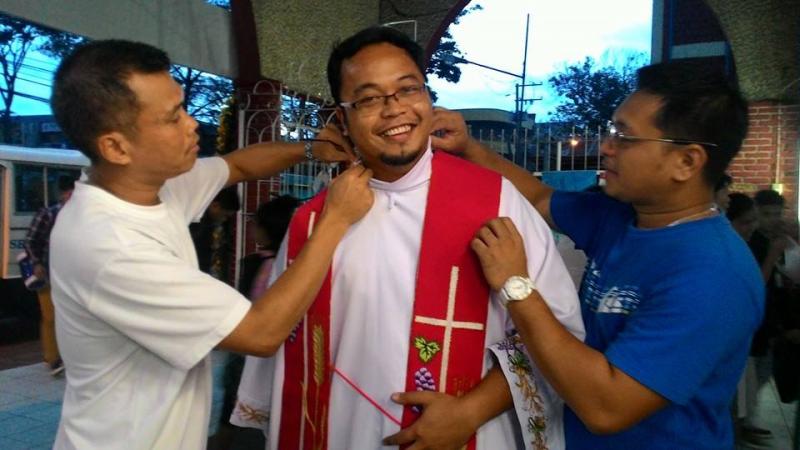
Bernie, Father Kurt and John Yecyec
My work entails much traveling, crossing seas and mountains. Sometimes I need to travel at dawn or at night to catch up with the schedules as the vocation team conducts recollections and seminars, visits schools, meet interested inquirers and follows up on candidates from different towns and regions. This is the reality of my work. It is tiring, and I have to be away from my family most of the time.
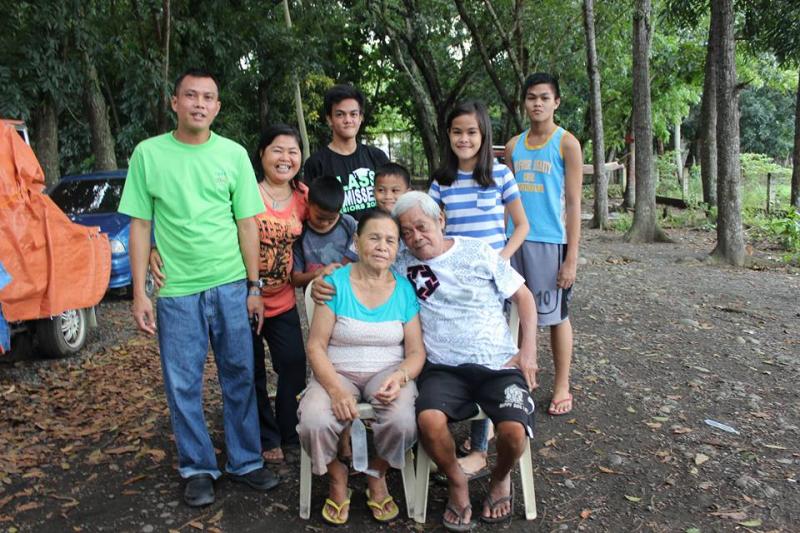
Bernie's Family
Being a family man I experience various challenges. I have to attend my family’s needs in the limited time I can spend with them. The greatest challenge was when my wife Laga was diagnosed with a brain tumour in October 2011. She had two operations in the same month, because of an infection after the first. The aftercare was quite demanding as I had to look after Laga myself. The healing process was slow until a follow-up operation in 2014, in God’s mercy, made her condition much better.
This period hasn’t been easy. Sometimes it has been just like a blur. At the height of Laga’s condition, having to take care of her and of my children, I reached a point where I almost gave up.
What helped me continue was the love and support of the Columbans. They did not put pressure on me but rather allowed me to find the rhythm needed to juggle my family situation and my work responsibility. They have been very generous and understanding. In return, I have found ways of accomplishing things even if I have to be with my wife and children. In spite of the challenges I face each day, my enthusiasm to continue inviting young people to follow Christ as Columbans is still burning.
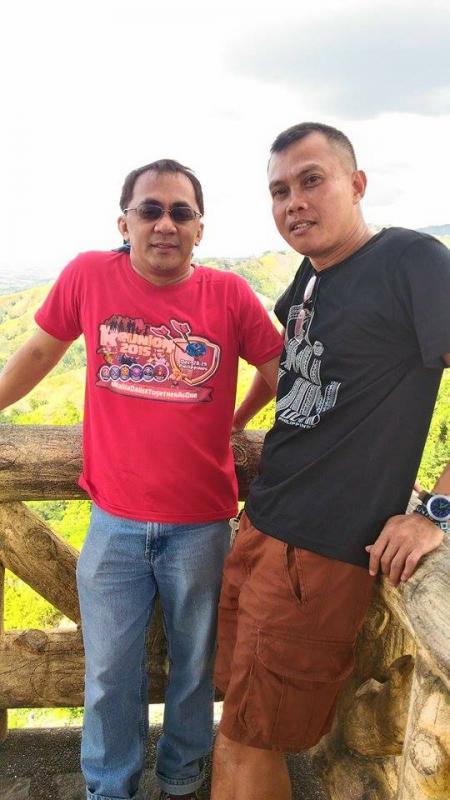
Bernie with the vocation director, Fr Jovito Dales
A vocation is always a gift. Embracing one’s vocation is more than a gift because it is through following it that you can use your talents to fulfil Christ’s Mission. Oftentimes in our vocation promotion, students ask me, ‘Pari pud ka?’ (Are you a priest too?). I usually reply in jest, ‘Dili uy! Padre de pamilya ako.’ (Of course not! I’m the father of a family’.) Father Kurt’s vocation as a priest and my vocation as head of my family may be different. We follow our different paths but are both heading towards the same goal, the ultimate purpose of continuing Christ’s mission here on earth.
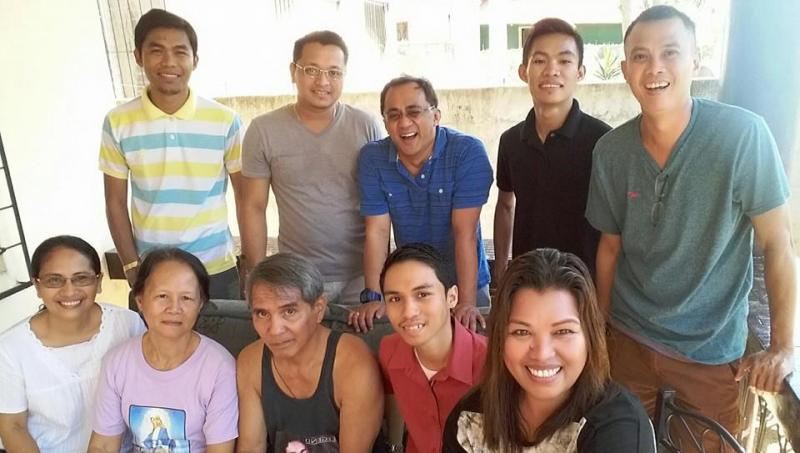
Vocation team on a family visit
‘Kumusta naman ang college student?’ (‘How is the college student?’) I asked my eldest, Billy. ‘OK ra man’ (‘Just OK’), he replied. ‘Ug kumusta man ka sa imong course?’ (‘And how are you doing in your course? ‘OK ra man’, again, came his uninterested reply. So I asked him another question, ‘Wa ka nagplano nga mag-pari?’ (Are you not planning to be a priest?’) His reply struck me, as I hadn’t expected it, ‘Naghunahuna pud ko ana, Pa.’ (I’m also thinking about that, Pa.) It got me thinking. Why not?
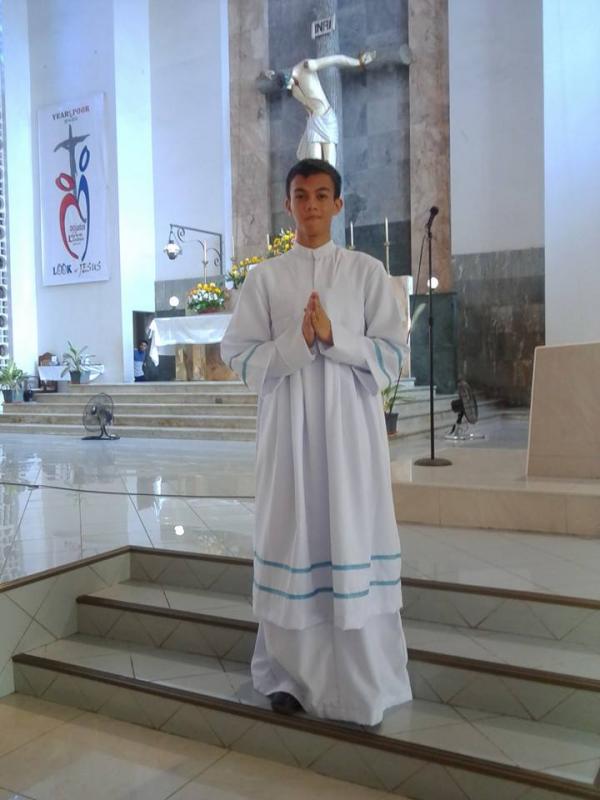
Billy Durangparang, eldest son of Bernie and Laga, in Ozamiz Cathedral.
Peace By Peace

PEACE BY PEACE |
|
Photo caption – Pope Francis, 13 December 2015, opening the Holy Door in the Basilica of St John Lateran. |
|
What are we trying to do? We are trying to get to heaven, all of us. We are trying to lead a good life. We are trying to talk about, and write about, the Sermon on the Mount, the Beatitudes, and the social principles of the church. It is most astounding – the things that happen when you start trying to live this way. Dorothy Day, All the Way to Heaven: the Selected Letters of Dorothy Day Pope Francis on Dorothy Day: In these times when social concerns are so important, I cannot fail to mention the Servant of God Dorothy Day, who founded the Catholic Worker Movement. Her social activism, her passion for justice and for the cause of the oppressed, were inspired by the Gospel, her faith, and the example of the saints.
|
|
All men seek peace first of all with themselves. That is necessary, because we do not naturally find rest even in our own being. We have to learn to commune with ourselves before we can communicate with other men and with God. A man who is not at peace with himself necessarily projects his interior fighting into the society of those he lives with, and spreads a contagion of conflict all around him. – Thomas Merton, No Man is an Island Pope Francis on Thomas Merton: A century ago, at the beginning of the Great War, which Pope Benedict XV termed a ‘pointless slaughter’, another notable American was born: the Cistercian monk Thomas Merton. He remains a source of spiritual inspiration and a guide for many people. In his autobiography he wrote: ‘I came into the world. Free by nature, in the image of God, I was nevertheless the prisoner of my own violence and my own selfishness, in the image of the world into which I was born. That world was the picture of Hell, full of men like myself, loving God, and yet hating him; born to love him, living instead in fear of hopeless self-contradictory hungers’. Merton was above all a man of prayer, a thinker who challenged the certitudes of his time and opened new horizons for souls and for the Church. He was also a man of dialogue, a promoter of peace between peoples and religions. Photo: Christian Community Bible (use jpg) – Psalm 119:30-32 (Christian Community Bible) |
|
When someone strips another of his clothes, he is called a thief. Should not someone who has the power to clothe the naked but does not do so be called the same? The bread in your larder belongs to the hungry. The cloak in your wardrobe belongs to the naked. The shoes you allow to rot belong to the barefoot. The money in your vaults belongs to the destitute. You do injustice to everyone who you could help but do not. St Basil the Great (329 or 330 – 379)
Christianity means community through Jesus Christ and in Jesus Christ. No Christian community is more or less than this. Whether it be a brief, single encounter or the daily fellowship of years, Christian community is only this. We belong to one another only through and in Jesus Christ. Dietrich Bonhoeffer (1909 – 1945) |
|
|
To Search is To Find
1. From ten-year old Abe: ‘My (non-Catholic) teacher says that we do not pray to the saints. How come I saw a card saying, “PRAYER TO Saint Michael”?’

The Annunciation, El Greco, 1600s
Toledo Museum of Art, Toledo, Ohio [Web Gallery of Art]
The painting above by El Greco shows two of God’s creatures, the Blessed Virgin Mary and St Gabriel the Archangel. God decided to become one of us in the person of Jesus Christ, God the Son who became Man. Jesus spent nine months in the womb of his Mother. God the Father didn’t send Jesus ‘ready-made’. Nor did God choose to speak directly to Mary. He spoke to her through the Angel Gabriel. Yet God the Father was clearly sending Jesus Christ his Son, God who became Man, to us – but through Mary. And clearly God was speaking to Mary – but through St Gabriel.
Prayer to Mary and to the saints is a bit like that in reverse. We can pray directly to God if we wish. And in the Holy Sacrifice of the Mass, our most important prayer, we always pray directly to the Father, through Jesus Christ his Son, God who became Man. On feast days of Mary and of the saints we don’t pray to them. Rather, we thank God for them, for the way they drew close to him by doing his will.
Since God the Father gave Mary the mission of bringing his Son Jesus Christ, God who became Man, to us and of bringing us to the Father through her Son, it is impossible that if we pray to her that she would lead us away from God.
In October 1997 I visited Hong Kong with Fr Peter Leonard, a Columban priest who has died since. (I had won a free trip for two in a St Patrick’s Day raffle in Manila the previous March!). On Mission Sunday we decided to go to the special Mass in the main stadium there. We weren’t quite sure where it was. But on the way we saw many Filipinos who seemed to be going there. So we asked a group of them how to get there. They gave us clear instructions. We didn’t think that they would lead us astray. And they didn’t, of course. Praying to the saints is a bit like that. Since they are already in heaven, giving glory to God, they want us to be with them there and cannot possibly lead us astray.
And if someone asks me to pray for him or her that person isn’t putting me in the place of God but is asking me for help in some situation along the path of life. Praying to the saints is just like that.
2. My 90-year old grandmother, asked me, ‘Is it possible for our marriage to be consecrated?’ She and my deceased grandfather had wished to be married in a Catholic church but for financial reasons they opted for a civil wedding. Is it possible, Father? As she expressed, she would be more than happy for a simple Mass said for this special intention.
Pope Francis on the Beauty of Marriage
Only two living people can marry. I am sure that your grandmother and grandfather loved each other and deep down they wanted to celebrate the Sacrament of Matrimony. God knows what’s in the depths of our hearts.
Here in the Philippines a civil wedding is just as expensive as a church wedding. You have to pay for a marriage license and you pay a fee to the judge or mayor or whoever officiates at a civil wedding. But there is a widespread perception that if you have a church wedding you must have an expensive celebration, buy expensive gowns for the bride and bridesmaids, etc. This perception is utterly wrong. The Church does not ask any couple to have an expensive wedding. It is families and couples who decide that there must be a ‘big show’ or who decide to wait until they can afford such. Meanwhile, Jesus is patiently waiting to be invited.
The essence of the Sacrament is that the bride and groom invite Jesus himself to be the foundation, the source of their love for each other. His love is a source that can never grow dry. A couple who choose to have a civil wedding are, if they are Catholics, leaving Jesus standing outside even though he wants to come in, though that is not usually their intention. I know of couples who put off their church wedding ‘until my aunt who helped me through college comes home from the USA next year’ or for similar reasons. On the other hand I have friends living in Britain, the husband British and the wife Filipino. They had their church wedding in England, even though none of the bride’s family could attend. But when they visited the Philippines the following year they had a special Mass and celebration in the bride’s barrio so that her family, relatives and neighbors could share their joy.
St Paul reminds us that the Sacrament of Matrimony is a reflection of the love of Christ for his Church. Be subordinate to one another out of reverence for Christ . . . For the husband is head of his wife just as Christ is head of the church, he himself the savior of the body . . . Husbands, love your wives, even as Christ loved the church and handed himself over for her . . . This is a great mystery, but I speak in reference to Christ and the church. (Read Ephesians 5: 21-33).
A Catholic couple who choose to have only a civil wedding are not an image of the love of Christ for his Bride, the Church.
I would encourage your grandmother to go to confession. Perhaps she has done this already. If she is house-bound ask the parish priest to visit her, hear her confession and give her the Sacrament of the Sick. And she can ask the priest to offer Mass for the repose of the soul of your grandfather, her husband and that they will be reunited in God’s love in heaven.
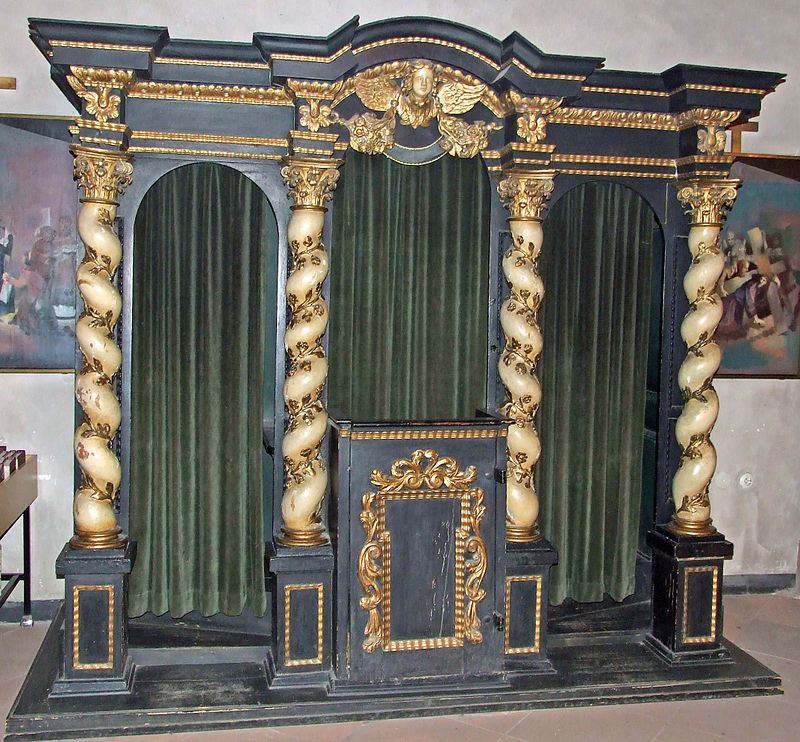
Confessional in Colombia [Wikipedia]
3. From a reader: What should I do if I am not ready to go to confession because I am not convinced that I would be walking the straight path once again? I’m afraid that I'd be committing the same mistakes/sins/faults all over again and end up by going back confessing the same things again? Today is my birthday and I would like to receive the Eucharist. It’s a month since I received Holy Communion. I want to receive in order to welcome another year of life but I’m hesitant to go.
Your editor asked a couple of friends in the Vatican for help in answering your question! One of them speaks in the video above and also in the video below. The other was asked a similar question by a child and you’ll find his answer below.
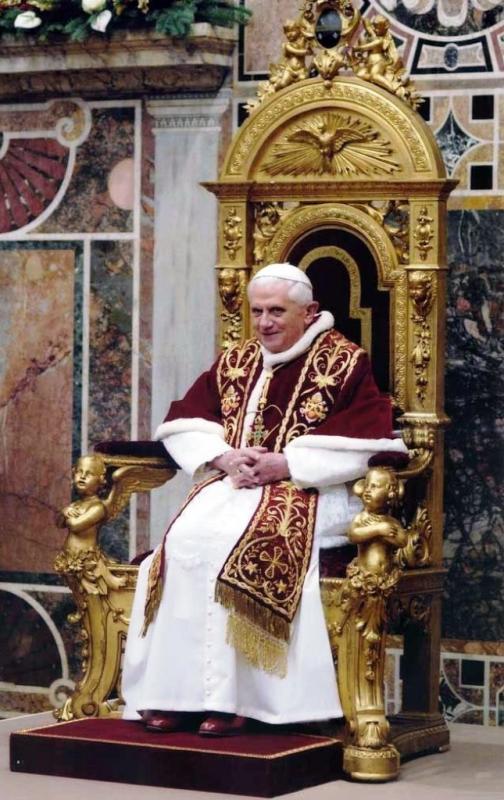
Pope Benedict XVI, 16 January 2013[Wikipedia]
Livia: Holy Father, before the day of my First Communion I went to confession. I have also been to confession on other occasions. I wanted to ask you: do I have to go to confession every time I receive Communion, even when I have committed the same sins? Because I realize that they are always the same.
I will tell you two things. The first, of course, is that you do not always have to go to confession before you receive Communion unless you have committed such serious sins that they need to be confessed. Therefore, it is not necessary to make one's confession before every Eucharistic Communion. This is the first point. It is only necessary when you have committed a really serious sin, when you have deeply offended Jesus, so that your friendship is destroyed and you have to start again. Only in that case, when you are in a state of "mortal" sin, in other words, grave (sin), is it necessary to go to confession before Communion. This is my first point.
My second point: even if, as I said, it is not necessary to go to confession before each Communion, it is very helpful to confess with a certain regularity. It is true: our sins are always the same, but we clean our homes, our rooms, at least once a week, even if the dirt is always the same; in order to live in cleanliness, in order to start again. Otherwise, the dirt might not be seen but it builds up. Something similar can be said about the soul, for me myself: if I never go to confession, my soul is neglected and in the end I am always pleased with myself and no longer understand that I must always work hard to improve, that I must make progress. And this cleansing of the soul which Jesus gives us in the Sacrament of Confession helps us to make our consciences more alert, more open, and hence, it also helps us to mature spiritually and as human persons. Therefore, two things: confession is only necessary in the case of a serious sin, but it is very helpful to confess regularly in order to foster the cleanliness and beauty of the soul and to mature day by day in life.
Pope Francis says something very striking: ‘Being ashamed in the sight of God is a grace.’ I remember a saintly teacher I had in high school, a religious brother. If he stared at you after you had done something wrong you felt ashamed. But it was the shame of being humbled, not the shame of being humiliated, a very different thing. Pope Francis is talking about being humbled as we realize how much God loves us in our sinfulness.

Logo of Jubilee Year of Mercy
Our Hideaway
On to the next bend
By Ruby Padasay
Mpwapwa
The author writes about her time as a VSO volunteer in Mpwapwa, Tanzania, from 29 June 29 2013 to 15 June 2015. Mpwapwa is a market town in the Dodoma Region of Tanzania.
I am not the kind who will last at anything for more than two years. I am not the kind who finishes anything I‘ve started. My parents had to make a deal to get me to complete my Bachelor’s Degree. I know the symptoms when I want to quit: I would sleep the whole day at home, pretending that I have a severe headache.
After graduating I worked at a call center for six months and then got bored. I knew I wouldn’t last another six months. I started to review what was happening in my life and decided to go to an assessment day of VSO (Volunteer Service Overseas) in Manila.
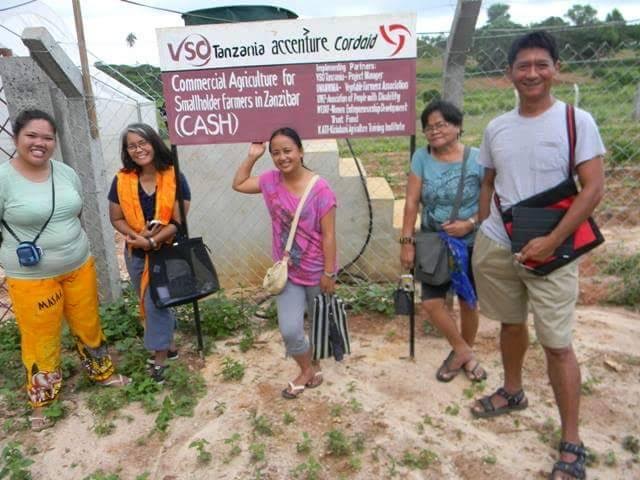
Ruby, far left, with other VSO volunteers
Though I had done a series of volunteer works in the Philippines I wasn’t sure about volunteering abroad. I am a person who believes in signs. If accepted I knew it would be for me. If not, it wouldn’t. I did my best during the assessment and really asked for a sign. I went with my cousin to Quiapo Church and prayed that I would make it – and I did.
It was difficult for my family to let me go. I’m not a ‘house person’ and my mom never seems to get used to my leaving home. She worries a lot and whenever she calls tells me that she prays for me to be safe and that God is with me. I have always believed in the strength of prayer, especially of parents.
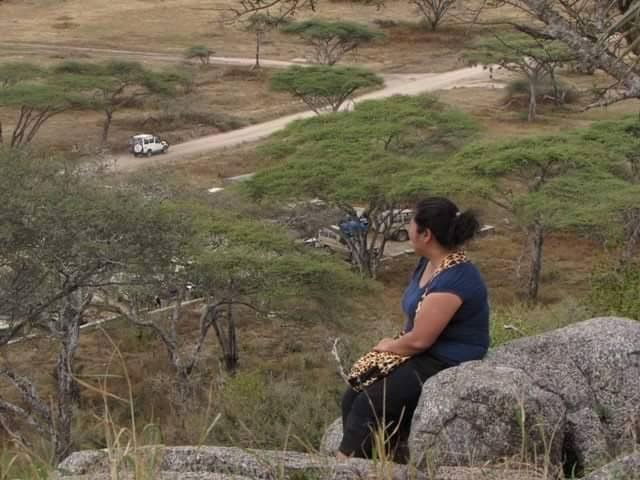
Ruby in a reflective mood in the Tanzanian countryside
I was in Tanzania when Mom was diagnosed with stage two breast cancer. I cried the whole night. Some friends made long distance calls after hearing about this. One of my closest friends, working in South Africa, called to ask about my decision. I said that I wanted to go home. My friend’s response was, ‘Why did you go to Tanzania in the first place? If you go home, will it change anything?’ I called Mom next day. She said there was no need to go home. Mom’s illness drew here closer to God, strengthened her relationship with my father and brought our family back to the Church. She’s been heroically fighting her illness and I draw a lot of strength from her. Her courage has become my courage here, in this place where I’m my own.
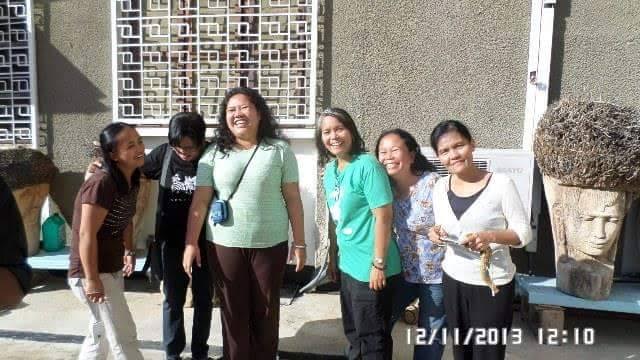
Ruby with Filipino VSO volunteers in Tanzania
My first three months in Tanzania were a period of adjustment. My values, beliefs and upbringing were challenged. Everything seemed to be different. Volunteering made me question many realities in life, made me think about my personal values, made me realize that there are some who have everything but still complain about many things.
Traveling was very difficult. We had to visit three colleges every quarter to train teachers. Bus rides often lasted eight hours. But traveling taught me some lessons. Seeing women wearing high heels while carrying their babies on their backs showed me how strong Tanzanian women are. Sometimes I saw them standing for five hours in crowded buses.
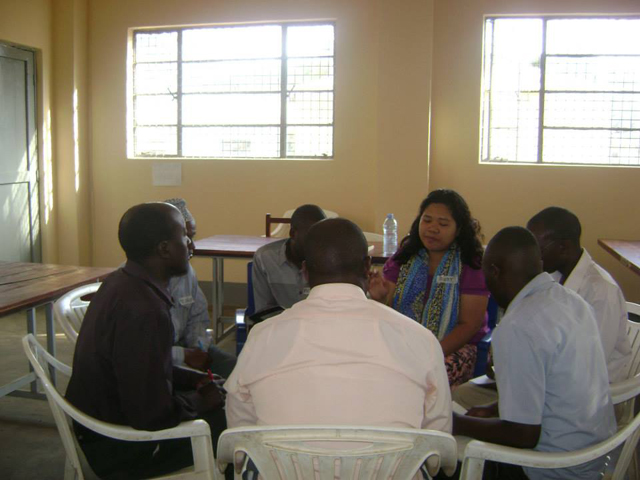
Ruby at a meeting with teachers
Tanzanians are generous. With the little that they have, they would still invite you for dinner! And I have found vendors to be people who would rather earn an honest penny than steal.
Market in Tanzania
For me, the best thing in Tanzania is the people’s respect for religion. There are times when Muslims and Christians pray at the same gathering. On such occasions, in order that everyone has something to eat and that no one is offended, chicken or beef, but not pork, is prepared. In the market you will stalls opposite each other where the owner of one is a Christian and of the other a Muslim. But they call each other ‘Brother’. It always fascinates me how in a place like that where Muslims and Christians are almost in the same number yet they still live in peace. [Editor’s note: It is estimated that around 35% are Muslim, 30% Christian and that 35@ practice traditional African religions.]
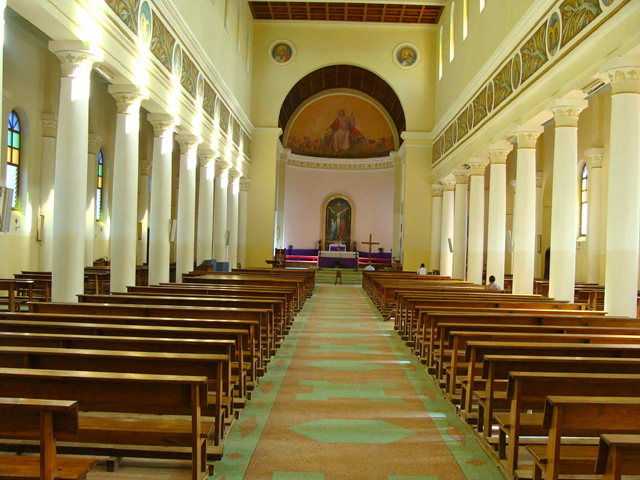
St Paul of the Cross Cathedral, Dodoma [Source: blog of Christina Bahati]
I didn’t know why I considered volunteering back then. I was a lost soul when I was inspired by my graduate school teacher who shared in class on how she was once lost too and finally found her purpose. Maybe this is a gift in itself, my ever wandering spirit always looking for something new. It has become my strength as a volunteer. No, I do not call it noble, admirable, heroic.
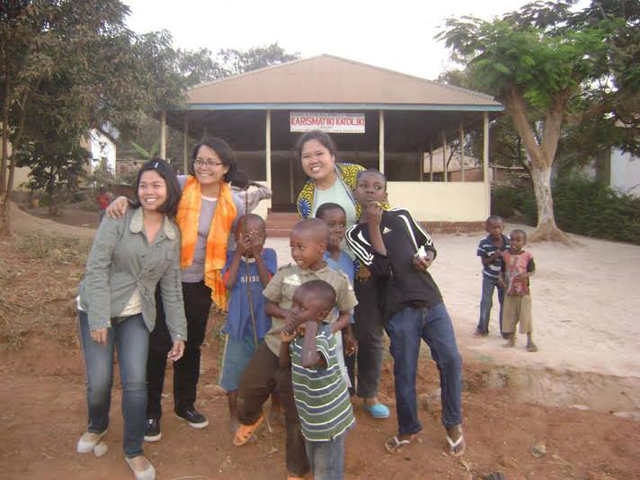
Filipino VSO volunteers and Tanzanina youngsters sharing a light moment
Volunteering is just my way of paying forward the love and generosity that my family and I have received from other people.
My term in Tanzania is over and now I’m here in Nepal on another mission. When it is time for me to go around the next bend on my journey I will be glad to once again pack my bags.
Since we are travelers and pilgrims in the world, let us ever ponder on the end of the road, that is of our life, for the end of our roadway is our home (St Columban, 8th sermon).
St Martha Catholic Choir, ‘Safari’, Dar Es Salaam, Tanzania


